Space
The planet Mars; Everything you need to know
Published
3 months agoon


The planet Mars; Everything you need to know
Today, we can say that Mars is one of the most familiar places in the solar system, thanks to numerous explorations and discoveries. Mars is the fourth planet in the solar system (based on distance from the Sun) and the second smallest planet after Mercury. The name Mars or Mars is inspired by the Roman god of war and is often known as the Red Planet.
Table of Contents
-
Why is Mars called the red planet?
-
How was the planet Mars formed?
-
Why is Mars smaller than Earth?
-
Physical characteristics and composition of the planet Mars
-
The internal structure of the planet Mars
-
Surface features of the planet Mars
-
Holes and craters on the planet Mars
-
Martian ice caps
-
Aquifers
-
Life on Mars
-
The atmosphere and climate of the planet Mars
-
The magnetic field of the planet Mars
-
Rotation and orbit of the planet Mars
-
Moons of Mars
-
The wonders of the planet Mars
-
land and sea
-
Channels of Mars
-
face of mars
-
Martian tree
-
The Martian
-
Gandhi’s face
-
Alpha biological station
-
Blue spider
-
Martian beetle
-
Big discharge
-
Strange green stone
-
Observations and explorations of the planet Mars
-
Perseverance mission
-
Manned missions
-
NASA
-
SpaceX
-
The impact of travel to Mars on humans
The abundance of iron oxide in the crust of Mars is the main reason for the red color of the soil. The days and seasons of Mars are similar to Earth’s to a great extent, due to the similarity of the rotation period around the Sun and its axial rotation to Earth. The largest volcanic mountain and the second highest mountain in the entire solar system is located on Mars, and Marineris Valley is one of the largest valleys in the solar system. Mars has two moons named Phobos and Deimos, which have an irregular shape, unlike Earth’s moon. Probably, these two moons were asteroids that were trapped by the gravity of Mars.
Mars is a cold planet and a desert world with a very thin atmosphere. Martian dust storms are so intense that they can cover the entire surface of the planet. The temperature of this planet is so low that the carbon dioxide in the atmosphere directly falls on its surface in the form of snow and ice.
The volume of water ice deep in the Antarctic ice cap of Mars is enough to cover the entire surface of the planet up to a depth of 11 meters. In November 2016, NASA reported findings of subsurface ice on the Utopia Panitia plate. According to estimates, the volume of water discovered is equal to the volume of water in Lake Superior of North America. Mars can be easily seen from Earth with the naked eye as a red dot.
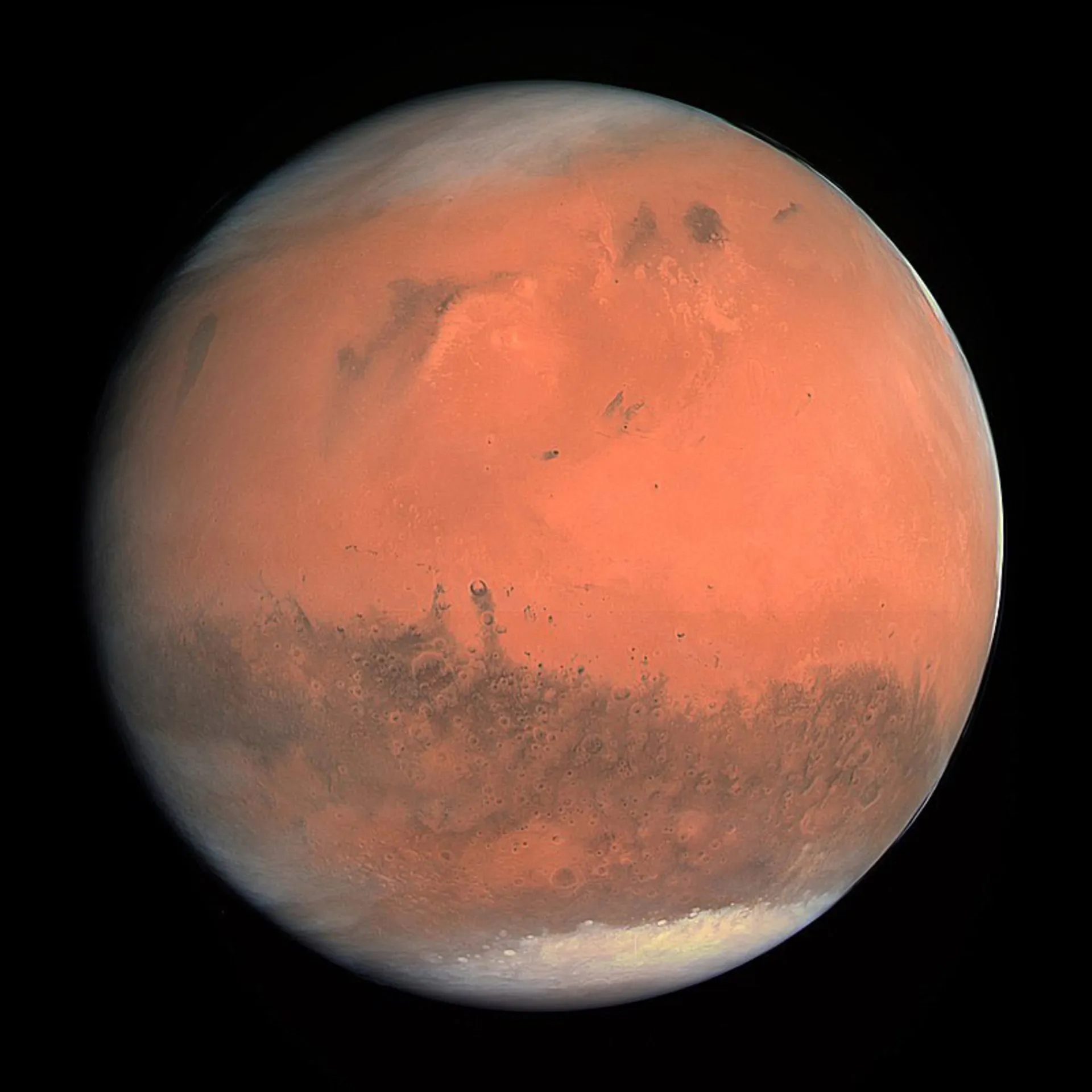
This color image of Mars was captured by the OSIRIS instrument of the European Space Agency’s Rosetta spacecraft in February 2006.
Why is Mars called the red planet?
The bright copper color of Mars is due to the abundance of iron-rich minerals in its regolith. Regolith is loose rocks and dust that cover the surface. Earth’s soil is also a type of regolith, with the difference that it is rich in organic matter. According to NASA, iron minerals undergo oxidation or rusting, giving Mars its reddish appearance.
How was the planet Mars formed?
Approximately 4.6 billion years ago, in the early days of the solar system, a disk of gas and dust formed in the orbit of the young sun. Two theories show how, over millions of years, the rocky inner planets of the solar system formed from within this disk of matter. According to an older theory, the dust in the inner solar system formed into larger masses, and these masses gradually became the size of the Earth’s moon. The collision of these planetary embryos eventually led to the formation of planets such as Mercury, Venus, Earth, and Mars.
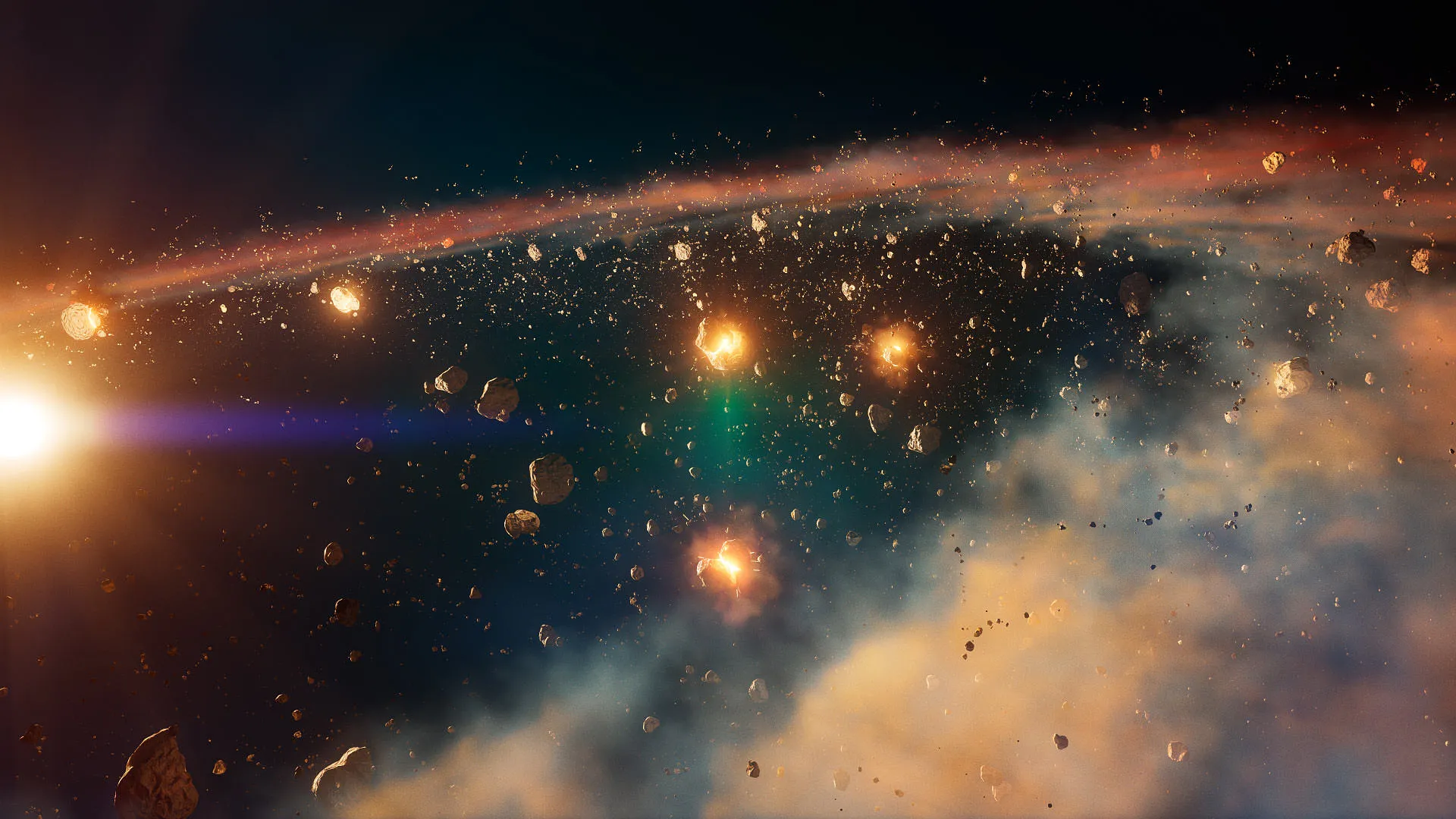
Artist’s conceptual image of the solar nebula, a cloud of gas and dust in which the planets of the solar system formed.
However, a newer theory considers a different growth process. In this process, millimeter-sized pebbles moved towards the sun from the outer part of the solar system. Along the way, these pebbles took the form of inner planetary embryos and gradually reached their current size. Both theories are based on theoretical models and computer simulations that aim to recreate the conditions and variables of the early solar system. Both theories also describe possible pathways of planet formation; But which theory is correct? Which process actually occurred?
Unlike Earth, which is tectonically active and rocks change over billions of years, Mars has no tectonic activity; Therefore, the oldest Martian rocks are present on its surface. Studying these rocks is a way to find out how the red planet was formed. Also, scientists can answer these questions by examining extrasolar planets and their similarity to the planets of the solar system, as well as the same elements in the formation of Earth and Mars; But none of the theories have been conclusively proven yet.
Why is Mars smaller than Earth?
The size of a planet depends on the amount of matter and the initial cloud of gas and dust. According to NASA, the radius of Mars is nearly 3390 km; But Mars is not perfectly circular like Earth. Rather, due to the rotation, it has a slight bulge in the equatorial part. One of the main reasons why Mars is small compared to Earth is the difference in gravity between the two. The gravity of Mars is about one-third that of Earth because it has less mass to attract objects to its surface. This feature can be useful for research and discoveries to some extent. For example, the Ingenuity helicopter flies more easily and takes off from the surface of Mars due to lower gravity; But this gravity has its problems and makes the atmosphere of this planet very thin.
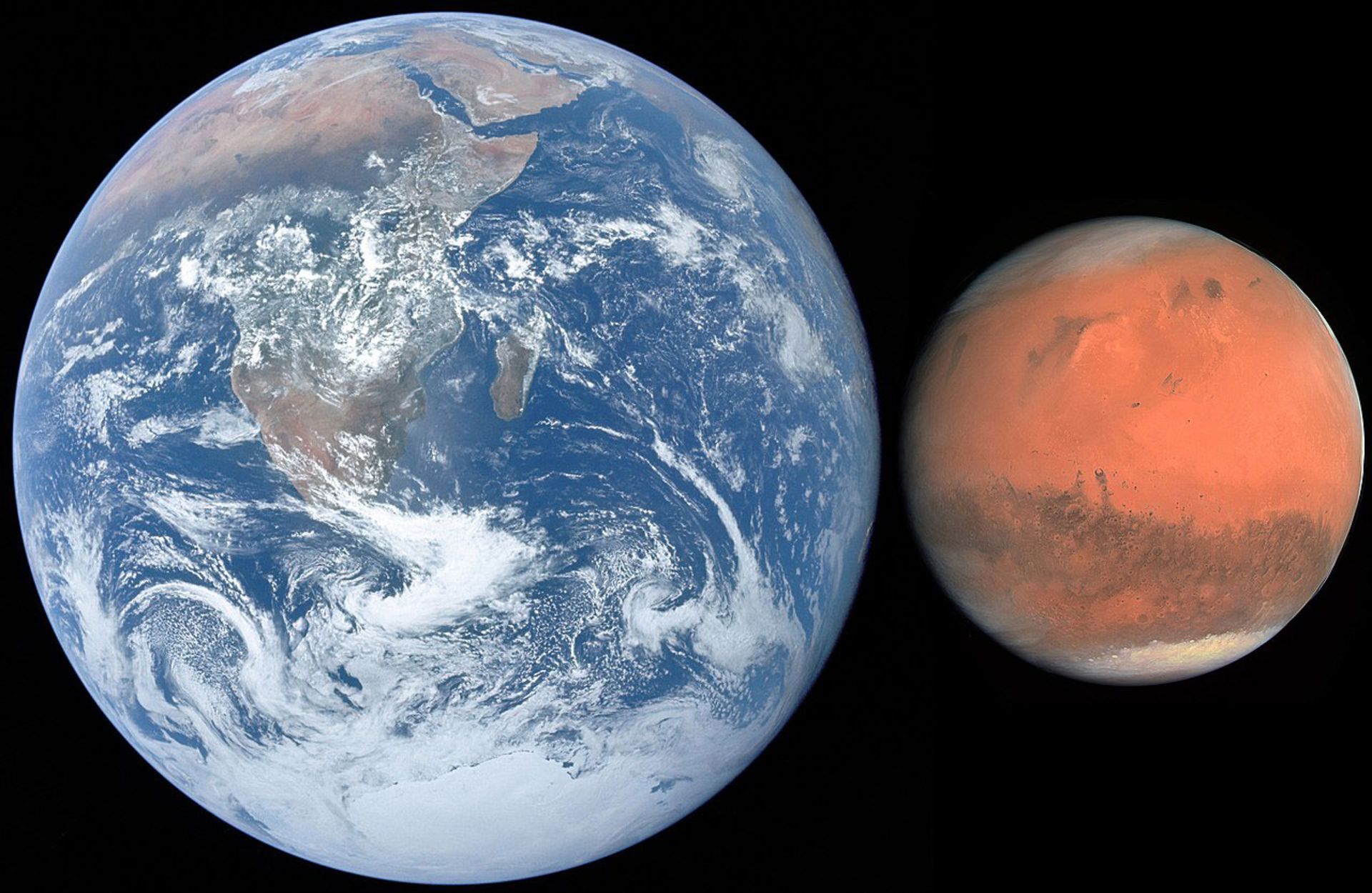
Comparison of Earth and Mars
Physical characteristics and composition of the planet Mars
The diameter of Mars is half the diameter of the Earth and its surface area is slightly less than the land area of the Earth. Mars is less dense than Earth. Its volume is 15% of the Earth’s volume and its mass is approximately 11% of the Earth’s mass; As a result, the gravity of Mars is 38% of the gravity of Earth. Therefore, a person weighing 100 kg on Earth will be 62 kg on Mars, but his mass is the same on Earth and Mars.
The internal structure of the planet Mars
The dust that covers the surface of Mars is like talcum powder. Under a layer of dust, the Martian crust is placed, most of which is made up of basalt volcanic rocks. Mars soil contains nutrients such as sodium, potassium, chloride, and magnesium. The Martian crust is thought to be one piece. Unlike Earth, the Red Planet has no tectonic plates. Tectonics or plate tectonics float on the mantle and are the main cause of the deformation of the Earth. But since there is almost no movement in the crust of Mars, the molten rocks have gathered in one place and created huge volcanoes on the surface of this planet.
Of course, this does not mean that the shell is immobile. According to researches, probably strong thrusts have led to the creation of Martian slopes. According to the researchers, ice is an important material for smoothing drifts on Mars, even in tropical areas such as Valais Marineris. Any possible life on Mars is probably going on underground. Although astronomers continue to search for signs of past and present life on Mars, no evidence of Martian life has been found so far.
According to the evidence, there has been no volcanic activity on Mars for millions of years. The mantle of Mars is very silent and calm. The mantle is composed of silicon, oxygen, iron, and magnesium, and its thickness reaches 1240 to 1880 km, according to NASA. The center of Mars has a solid core of iron, nickel, and sulfur that does not move; Therefore, this planet does not have a global magnetic field; Without the presence of a magnetic field, cosmic rays hit this planet and turn it into an uninhabitable world.
NASA’s InSight rover has been investigating the interior of Mars since 2018. InSight has measured Martian earthquakes. InSight’s data revealed key insights into the planet’s internal structure. For example, according to the new estimates of this mission, the diameter of the core of Mars is between 1780 and 2080 km and the thickness of its shell is between 24 and 72 km. The mantle forms the rest of the structure. This is while the width of the earth’s core reaches 1,220 km and its mantle reaches 2,900 km. Also, the earth has two types of crust. Continental and oceanic crust, whose thickness is equal to 40 km and 8 km, respectively.
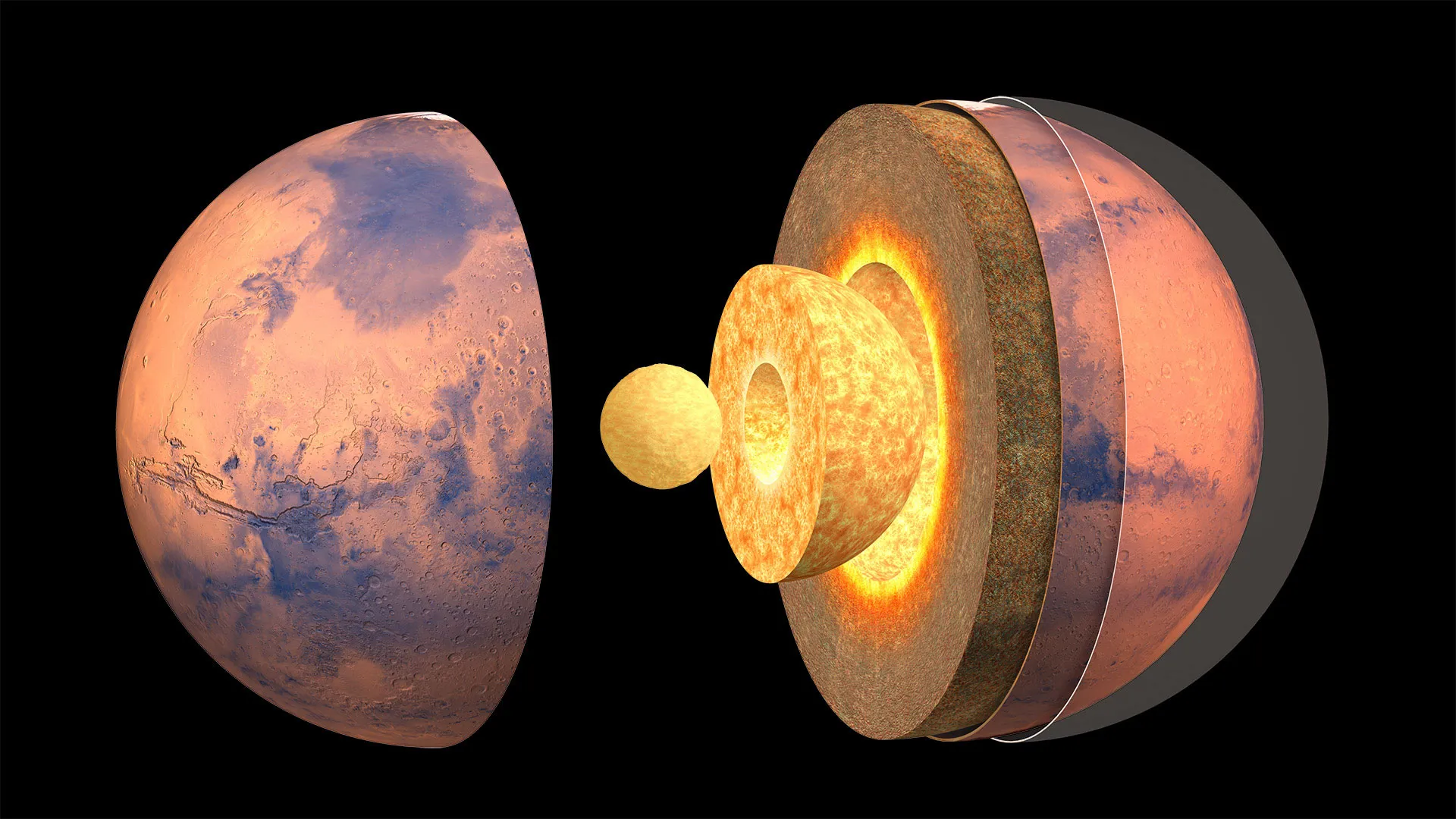
Surface features of the planet Mars
Mars hosts the highest mountains and the deepest and longest valley in the entire solar system. The height of Mount Olympus reaches 27 km, which is almost three times the height of Mount Everest. The depth of the Marineris Valley of Mars is seven kilometers and its width reaches 4000 kilometers from east to west, which is almost equal to the width of Australia.
Scientists believe that the Marineris Valley was created by scratching and stretching the crust. The width of independent internal valleys reaches 100 km. The valleys merge in the central part of the Marineris Valley in an area 600 km wide. Large channels rising from the end of some valleys and layered sediments show that the valleys were once full of water. Mars has the largest volcanoes in the entire solar system, Olympus Mons being one of them. The diameter of this huge volcano reaches 600 km and is so wide that it contains the state of New Mexico.
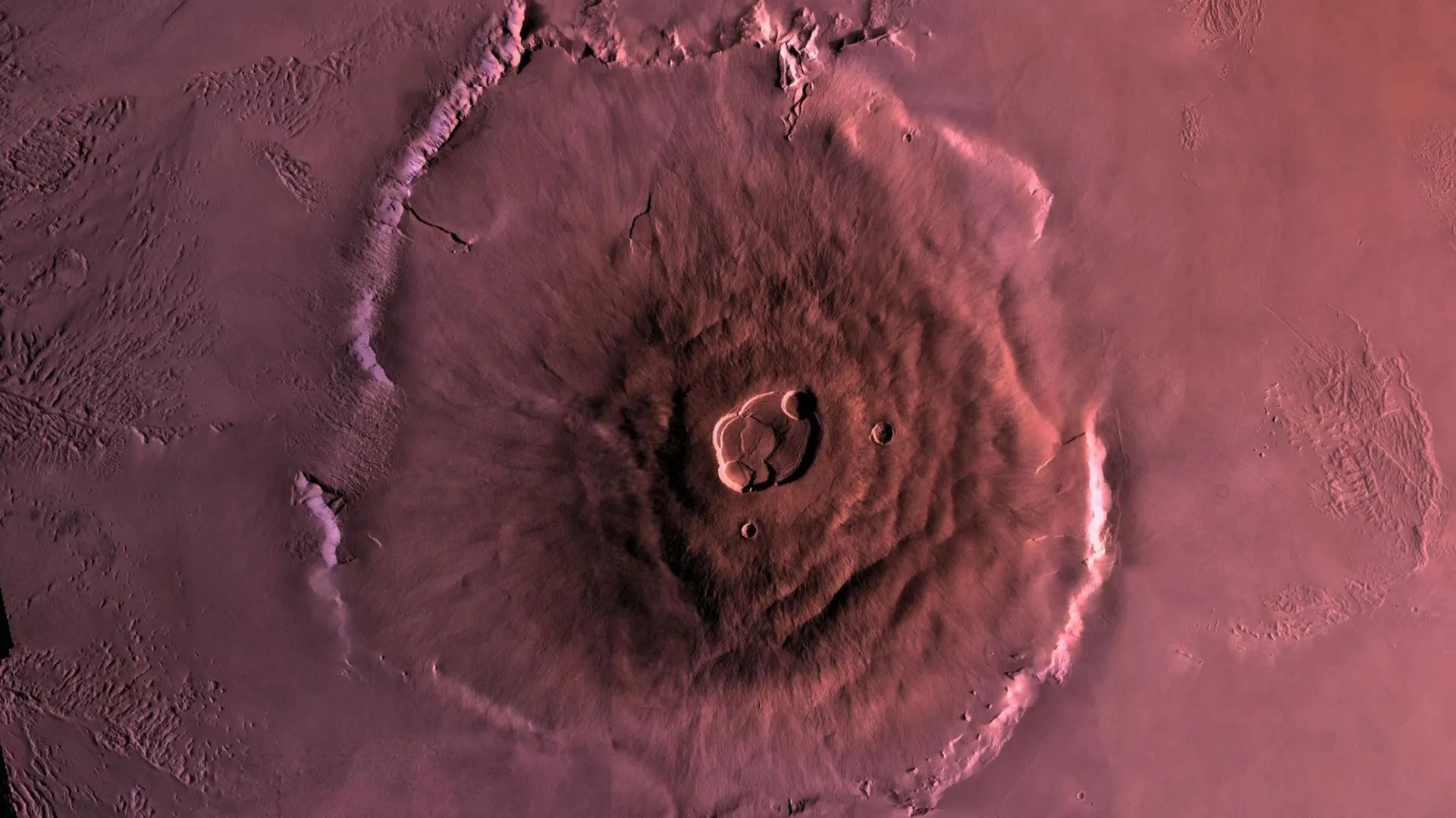
Olympus Mons is the largest known volcano in the solar system. This image was captured by NASA’s Viking 1 orbiter.
The canals, valleys, and water passages of Mars show that in the past liquid water flowed on the surface of this planet. Some channels are 100 km wide and 2000 km long. Liquid water may be found in cracks and holes in the subsurface rocks of Mars. According to a 2018 study, the salty water beneath the surface of Mars could contain significant amounts of oxygen, which is necessary for microbial life. However, the amount of oxygen depends on both temperature and pressure; The change in the deviation of the rotation axis of Mars causes changes and temperature fluctuations.
A large part of Mars consists of low and flat plates. The northern lands of Mars are among the flattest and smoothest plates in the entire solar system, which were probably formed due to the flow of water on the surface. The surface height in the northern hemisphere of Mars is lower than in the southern hemisphere, and this means that the northern crust is thinner than the southern crust. The difference between north and south could be due to a very large collision that occurred soon after the birth of Mars.
Holes and craters on the planet Mars
The number of craters on Mars varies in different places and based on the age of the surface. A large part of the southern hemisphere of Mars is very old, as a result, there are many craters in this area, the most famous of which is Hellas Planitia with a width of 2300 km. On the other hand, the northern hemisphere of this planet is younger and has fewer craters. Some volcanoes also have a small number of craters, which indicates that they have recently erupted and the resulting lava has covered the old craters. Some craters have strange deposits of pebbles around them that look like dried mudflows, possibly indicating the presence of subsurface water or ice.
Martian ice caps
Mars has two prominent ice caps; which are in continuous darkness in polar winter and 25-30% of atmospheric carbon dioxide gas is accumulated in this part in the form of dry ice. When the poles are exposed to sunlight, the frozen carbon dioxide turns back into a gas. These seasonal processes transport a large portion of water vapor and dust, creating Earth-like snow and large cirrus clouds. 70% of the polar ice caps are water. Frozen carbon dioxide also sits in the form of a thin layer with a thickness of approximately one meter only in the winter season on the northern cap, while the thickness of dry ice on the southern cap reaches eight meters.
Aquifers
Due to the thin atmosphere of Mars, its surface conditions are not very favorable for water flow. For this reason, the possible sources of water are either underground or placed in the form of ice caps at the poles. According to past modeling, some of the Martian waters are underground. There are many signs of water in the impact craters; Among the canals that have grooves in their walls due to the passage of water and evidence of erosion and coastlines. As a result, craters may be a clue to underground water.
In the bed of these craters, there is evidence of the existence of water flows in the past, which have settled down over time. According to estimates, the depth of the channels corresponds to the oceans of Mars four billion years ago. Thus, the discovery of water became a prelude to the discovery of life on Mars.
The volume of water in Mars’ Valais Marineris canyon system exceeds expectations
In 2021, the FREND instrument from the Tracer Gas Orbiter (TGO) discovered subsurface water on Mars. The instrument discovered a region with an unusual amount of hydrogen in the Valles Marineris canyon system. Considering that the hydrogen element is abundant in water molecules, it seems that forty percent of the material near the surface of this region is water. This area is as rich in water as the Netherlands. This amount of water in this area, which was much more than expected, could be in the form of ice or water in the soil minerals.
In early 2022, the MRO orbiter discovered traces of water that appeared to have flowed on the surface of Mars 2-2.5 billion years ago. According to previous estimates, the surface water of Mars has evaporated about 3 billion years ago. As a result, based on this finding, the surface water of Mars has flowed on the surface of this planet for a billion years longer than the estimates.
Life on Mars
Water is the basic requirement of life. The discovery of water, especially underground liquid water, has increased the hope of discovering Martian life; But to understand the potential of Martian life, it is necessary to go back to 3-4 billion years ago. At that time, Mars and Earth had many features in common. The red planet was hot and humid, had a stable atmosphere, and was far from its current cold and unpleasant face. David Parker, European Space Agency’s Head of Robotics and Human Exploration, says:
At the beginning of its life, the raw materials of the planet Mars were similar to the materials that make up the Earth; But over time, everything changed. This process was just like a kind of collapse.
Mars lost its magnetic field over time. The loss of the magnetic field means that the planet will have no protection against harmful radiation. Mars also lost much of its atmosphere. Because the atmosphere is one of the other necessary criteria for the formation of life on the planet and provides the necessary oxygen. Parker says:
Mars still has a thin atmosphere, most of which is carbon dioxide. The reason for the extreme cold of this planet is its very thin atmosphere.

The Perseverance rover took this photo of the surface of Mars in January 2022. Perseverance is searching for signs of ancient life on Mars.
However, the cold and unprotected Mars did not discourage scientists from searching for signs of life on this planet. NASA’s Curiosity rover discovered organic matter on Mars in 2018. This discovery meant that the building blocks of life once existed or still exist on Mars. NASA researchers say:
Conservation of organic resources is a turning point in understanding life on Mars. Regardless of whether Mars has ancient life, its organic matter can be chemical clues to its current processes and conditions. Curiosity also discovered methane, the simplest organic molecule, on Mars. Methane can also be a clue of chemical processes on Mars.
According to the new findings of the Curiosity rover, evidence of ancient life on Mars has disappeared. The Curiosity rover made a surprising discovery by examining the clay sedimentary rocks around Gale Crater. This impact crater was once a lake that was created by an asteroid hitting the Red Planet about 3.6 billion years ago.
Clay is one of the most suitable sources for the search for evidence of life, and it is formed when the minerals in the rock are destroyed and turn red due to contact with water. Also, it is a good material for storing microbial fossils.
Curiasti sampled two ancient mudstones (a type of clay-containing sedimentary rock) from a dry riverbed, dating back to about 3.5 billion years ago, and both 400 meters apart. By examining these two samples, the researchers realized that one of the veins contained only half of the expected clay minerals. The other vein contained larger amounts of iron oxide, which is responsible for the red color of Mars.
According to researchers, seepages are the main culprit of the disappearance of ancient biological works: extremely salty and salty waters penetrating into clay layers rich in minerals make them unstable and lead to the disappearance of geological and biological works. In general, despite the many similarities between Earth and Mars, the Red Planet is not suitable for life for one simple reason. The diameter of Mars is exactly 53% of the diameter of the Earth (a little more than half); For this reason, Mars is not a suitable environment for maintaining volatile substances suitable for life, including water.
The atmosphere and climate of the planet Mars
Climate changes on Mars are extreme. The atmosphere of this planet was suitable for the flow of liquid water on the surface in the past, But today only a thin layer of it remains. The climate of Mars depends on several features such as ice caps, water vapor, and dust storms. Sometimes massive sandstorms can cover the entire planet like a blanket for months, turning its skies dusty and red. The atmosphere of Mars is 100 times thinner than the Earth’s atmosphere and 95% of it consists of carbon dioxide. According to NASA data, the atmospheric composition of Mars is :
- Carbon dioxide: 95.32%
- Nitrogen: 2.7 percent
- Argon: 1.6 percent
- Oxygen: 0.13%
- Carbon monoxide: 0.08%
- A small amount of water, nitrogen oxide, neon, hydrogen, deuterium, oxygen, krypton, and xenon.
Orbital images show fluvial sheets and possible vast ocean boundaries in Mars’ past. Although the Mars rovers have managed to discover evidence of limestone on the surface of Mars, there are still no clear reasons for the planet’s thin atmosphere. According to one theory, the low gravity of Mars, as well as the absence of a magnetic field, has made the atmosphere of this planet vulnerable to the pressures caused by the solar wind. Over millions of years, the pressure of these winds removed light molecules from the Martian atmosphere, thinning it. NASA’s MAVEN probe has been in charge of studying the atmosphere of Mars. According to other hypotheses, the collision with a small object may have led to the destruction of the Martian atmosphere.
The thin atmosphere of Mars and its great distance from the Sun is the reason for its very low temperature compared to Earth. The average temperature on Mars reaches minus 60 degrees Celsius. The temperature of Mars reaches minus 125 degrees Celsius near the poles and 20 degrees Celsius near the equator. Although the Martian atmosphere is much thinner than Earth’s, it is thick enough to retain weather, clouds, and winds. Huge dust storms have caused the surface of Mars to be covered with iron oxide dust. Dust is a stable part of the Martian atmosphere.
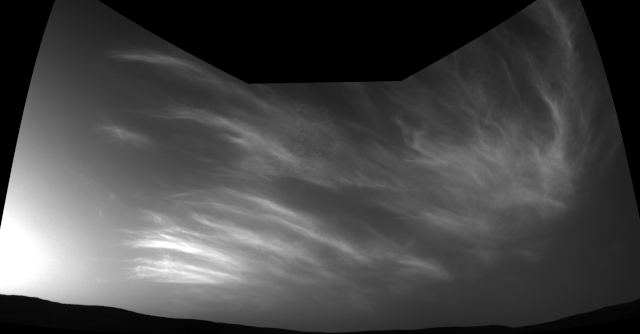
A view of Martian clouds captured by the Curiosity rover
The magnetic field of the planet Mars
Mars is deprived of a global magnetic field, but solar winds produce a type of magnetosphere or magnetosphere through direct reaction with the Martian atmosphere. On the other hand, according to the findings of the InSight probe, the magnetic field at the landing site of this probe is ten times stronger than predicted and fluctuates within a few seconds to several days.
Before the InSight mission, the best estimates of the magnetic fields of Mars were obtained from satellites in the orbit of this planet, whose average distance to Mars was 150 km. Mars had a global magnetic field in the distant past. The InSight magnetic sensor provided new clues about the phenomena of the upper atmosphere and the space environment around Mars. Just like Earth, Mars is exposed to solar winds; But since it lacks a global magnetic field, its protective insulation against the sun is weaker.
According to the researchers, the fluctuations of the magnetic field of Mars during the day and night are caused by the combination of the solar wind and the interplanetary magnetic field around the planet, and the solar rays produce a magnetic field by charging the upper atmosphere and producing electric currents.
Rotation and orbit of the planet Mars
Since Mars is farther from the Sun than Earth, its year is longer than Earth. Mars completes the orbit of the Sun during 687 Earth days; Therefore, the Martian year is equal to two Earth years. The length of days on Mars and Earth is almost equal. The rotation of Mars around its axis or a Mars day is 24 hours and 40 minutes. While the earth day is 24 hours.
Like Earth, Mars has different seasons, with the difference that the Martian seasons are usually longer, because the elliptical orbit of Mars around the Sun is a little more elongated than other objects; Therefore, when Mars is at its closest distance to the Sun, its southern hemisphere faces the Sun and experiences a short and hot summer; While a short and cold winter is going on in the Northern Hemisphere. When Mars is farthest from the Sun, its northern hemisphere faces the Sun. In these conditions, a long and moderate summer will flow, while the southern hemisphere will experience a cold and long winter.
Moons of Mars
American astronomer Asaph Hall discovered two moons of Mars named Phobos and Deimos in August 1877. The HiRISE camera of the Mars Orbiter captured two images of the two largest moons of Mars, Phobos and Deimos, on March 23, 2008. Ninety-four years after Hall’s discovery, the Mariner 9 spacecraft got a better view of the two moons of Mars. The most remarkable feature of Phobos is a ten-kilometer-wide crater that is half the width of the moon itself.
The moons of Mars are among the smallest moons in the entire solar system. Phobos is only slightly larger than Deimos and is located at a distance of 6000 km from the surface of Mars. Phobos orbits Mars once every three days. The more distant moon Deimos completes an orbit of Mars every thirty hours. The rotation direction of Phobos is inward and it gets closer to Mars by 1.6 meters every hundred years. Phobos may hit the surface of Mars in the next 50 million years and form a ring around it after collapsing.
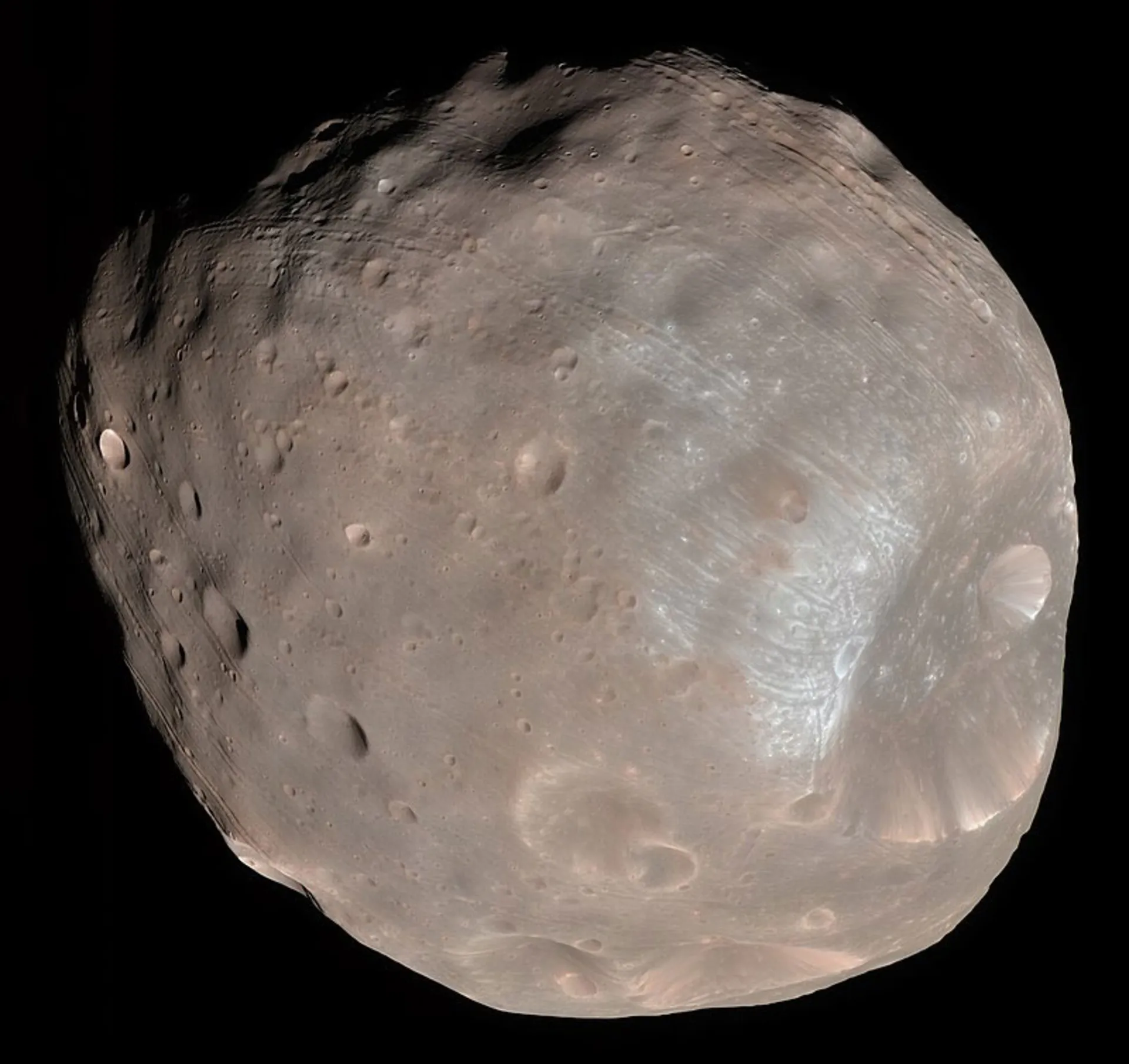
A color-enhanced image of Phobos captured by HiRISE. This photo shows crater chains and grooves on this moon.
If one were to stand on the moon Phobos, one would see Mars occupying more of the sky. In the future, this may become a hobby. According to scientists, in the future, one of the moons of Mars may be used as a base to observe the Red Planet and send a robot to its surface.
Phobos and Deimos, like Earth’s moon, have a tidal lock; Which means that only one side of them can be seen from Mars. Both moons are irregular in shape, full of craters and impact craters covered in dust and small rocks. Phobos and Deimos are the darkest objects in the solar system. These moons are composed of carbonaceous rocks with ice, which may be the result of asteroid collisions.
The gravity of Phobos is one-thousandth of the Earth’s gravity. A person’s weight of 68 kg in Phobos reaches 68 grams. The names of the moons of Mars are derived from the mythological sons of Ares, the Greek counterpart of Mars, the Roman god. Phobos means fear or terror (phobia) and Deimos means escape (fleeing after defeat).

Color-enhanced image of Deimos captured by HiRISE. This image shows the soft and smooth regolith cover of Deimos.
The wonders of the planet Mars
Humans have been seeing strange objects on the Martian surface for centuries. The reason for this issue can be the closeness of the conditions of Mars to host life or maybe Mars is close enough and can be observed more precisely. However, Earthlings were repeatedly fooled by the rocky surface of Mars and their illusions (such as finding channels to human faces and Martian bases); But all these findings turned out to be wrong. Here are some of the wonders of Mars:
Land and sea
According to Sir William Herschel’s notes in 1784, the dark areas of Mars are the oceans and the lighter areas are the Earth. According to the speculations of this famous British astronomer, Mars is surrounded by intelligent beings who probably have the same conditions as Earthlings. Herschel’s theory was the dominant theory for a century and even some astronomers claimed to have seen vegetation on the bright land of Mars. Fortunately, Herschel’s other astronomical achievements led to two powerful observatories being named in his honor. These theories were so strong that the Martian life theory was not very important.

Channels of Mars
Giovanni Schiaparelli, an Italian astronomer, observed grooves on the surface of the Red Planet during his close observation of Mars in 1877. He used the Italian word canali, which means channel, to describe these grooves and concluded that Mars has intelligent life that made these waterways.
Another astronomer, Percival Lowell, 1895 presented a plan for Martian canals in his book entitled “Mars, the Abode of Life”, which increased the popularity of this misconception. The theory of Martian canals was rejected in the early 20th century. At that time, the channels proved to be just visual errors. When you see Mars with weak telescopes, the point-like features of mountains and impact craters appear continuous, forming smooth lines. By spectroscopic analysis of light received from Mars, it was later proven that there is no water on the surface of this planet.
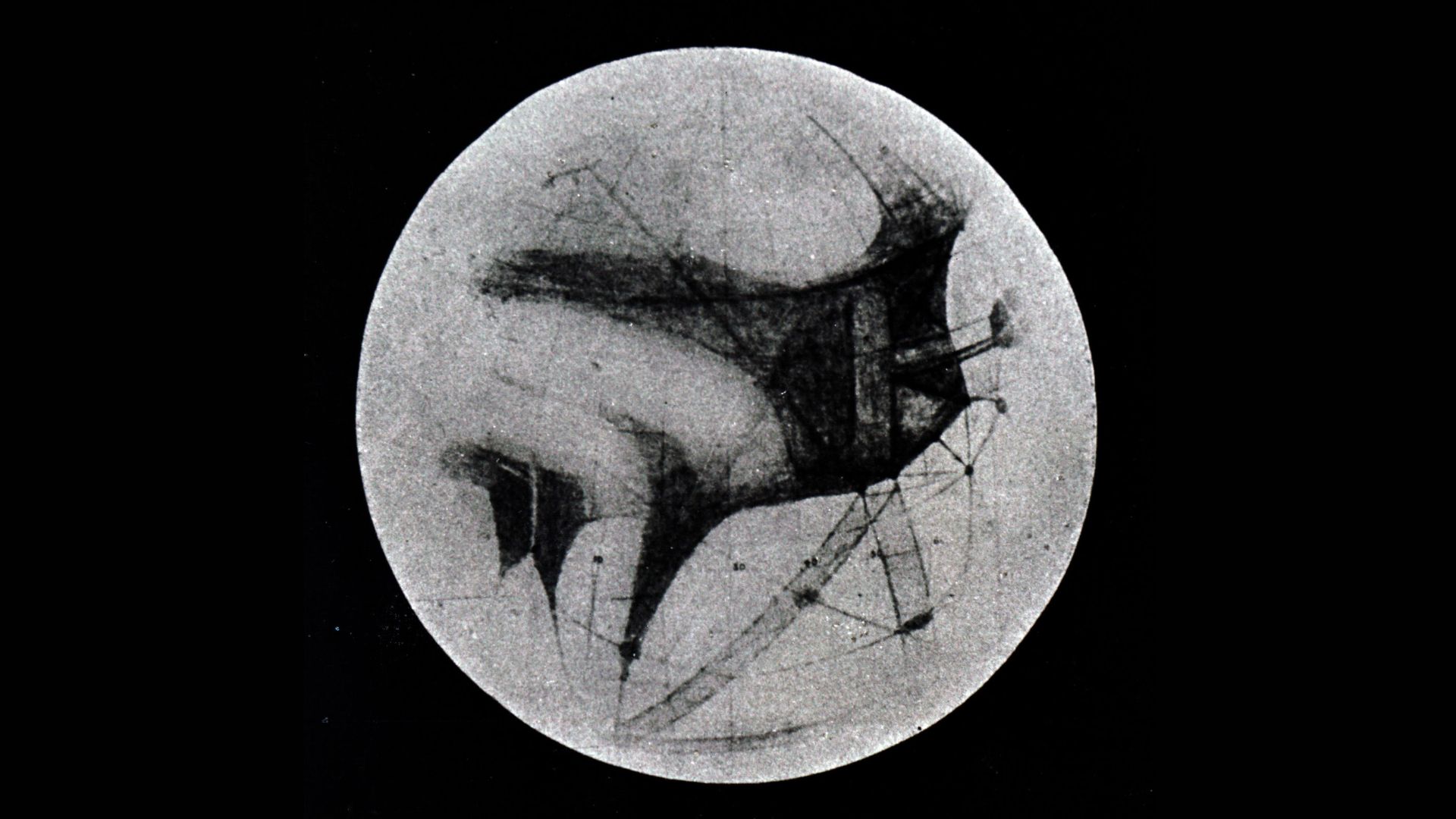
Face of mars
In 1976, NASA released an interesting image of a Martian mountain captured by the Viking 1 probe. The image showed a face with eyes and a nose. The Martian face inspired numerous myths and conspiracy theories for about thirty years, and many people believed that an ancient Martian civilization had created the face.
From the aerial angle, the shadows of the mountains of Mars look like faces; But from other angles captured by the Mars Express orbiter and other probes, the Martian mountain does not look like a face. Pareidolia is a scientific and psychological term that refers to seeing familiar faces or objects in different places. Facial pareidolia is the result of increased sensitivity to the details of the human face.
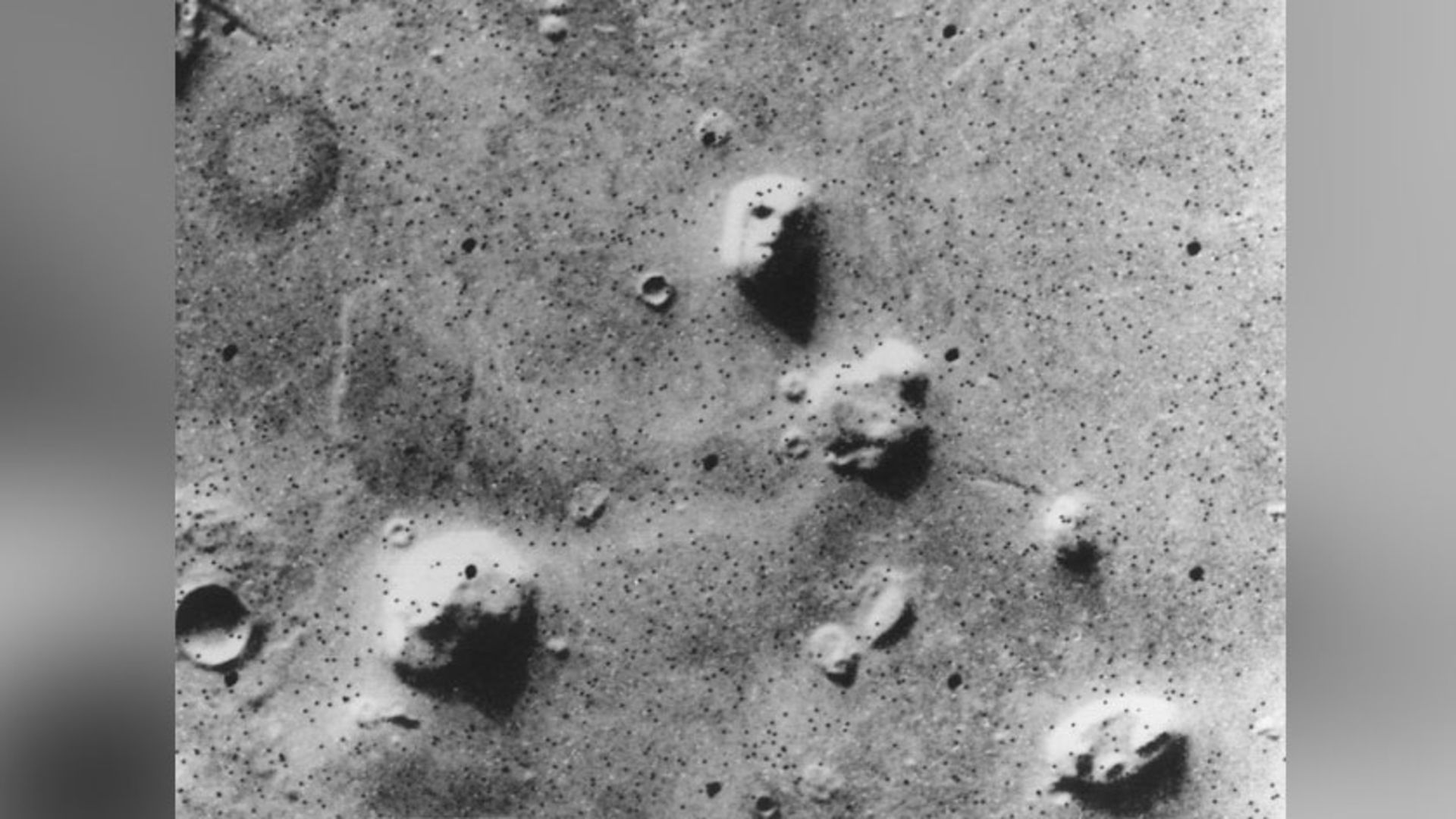
Martian tree
Arthur C. Clarke, the famous science fiction writer and author of “2001: A Space Odyssey”, announced seven years before his death that he saw streaks of vegetation, including trees, in new images from the Mars Global Surveyor. Clark says:
It’s like something like vegetation is moving with the seasons. I still hope we can find Martians. The branches and trees that Clark was talking about are actually geologically called “spiders”. These surface phenomena look like branches and change seasonally, But the reason for this is the seasonal melting of carbon dioxide ice covers in the poles of Mars. When the carbon dioxide ice is sublimated, it spreads in the form of branch streaks.
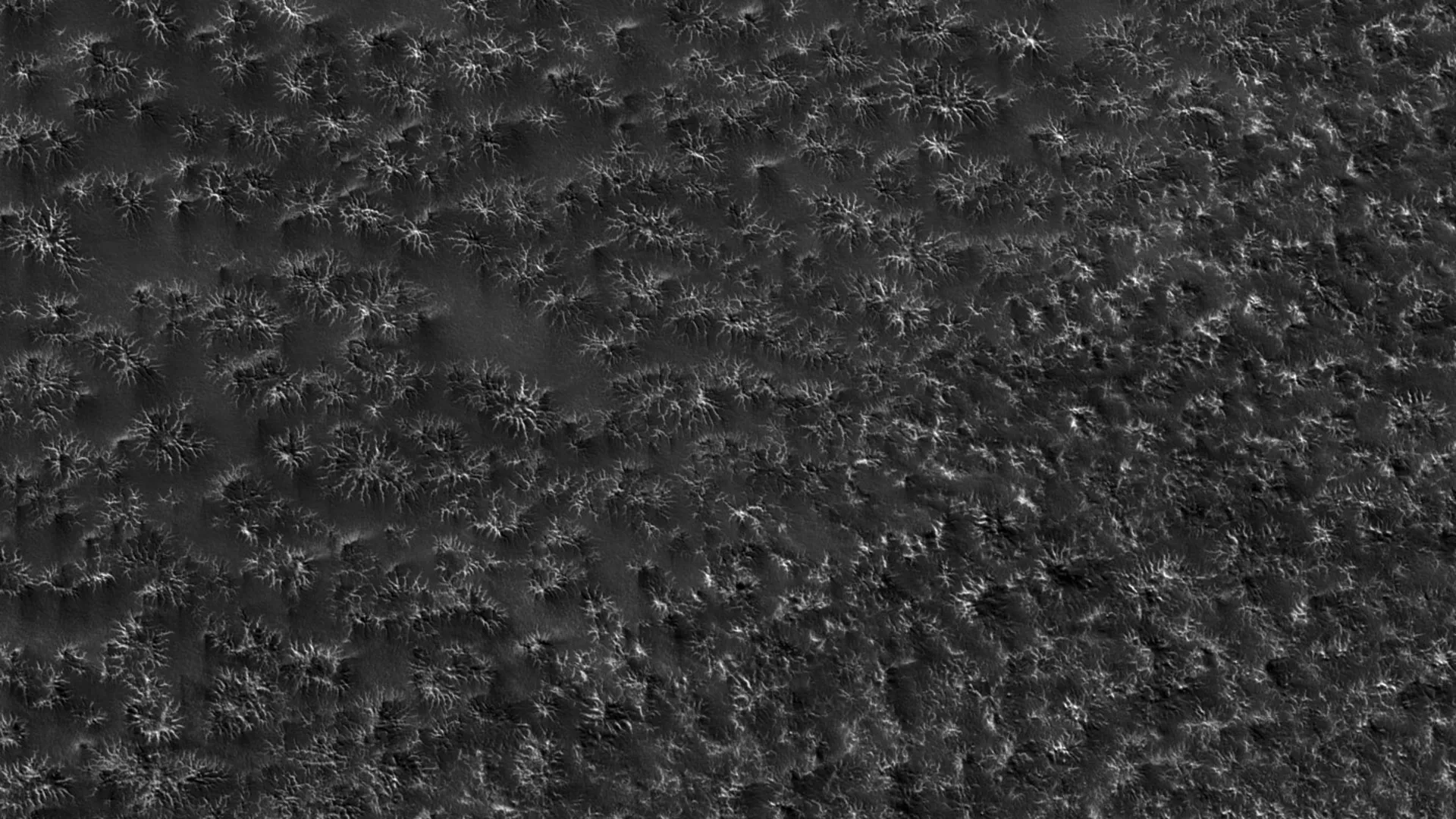
The Martian
In 2007, the Spirit rover captured an interesting sight on the Red Planet: a person wearing what appears to be a robe and kneeling in prayer. The Spirit rover captured a panoramic image of Home Plate, which is located in the Gosef impact crater in the Columbia Range. Of course, the subject of this image is a stone that looks like a human due to the phenomenon of paridolia.
Gandhi’s face
The face of Mars in 1976 was only the beginning of such illusions. With the launch of Google Mars in 2009, users were able to see the surface of Mars and examine all kinds of roughness. This program was created from a set of compiled satellite images. An Italian man named Matteo Iannio, by examining these images, found a bump that resembled the appearance of Mahatma Gandhi, the Indian independence leader who was killed in 1948. Higher quality images showed that the said image is not related to a mountain or a hill; Rather, it is a pit that looks like a human in profile. The effect of pareidolia can be easily seen in the comparison of low-quality and high-quality images.
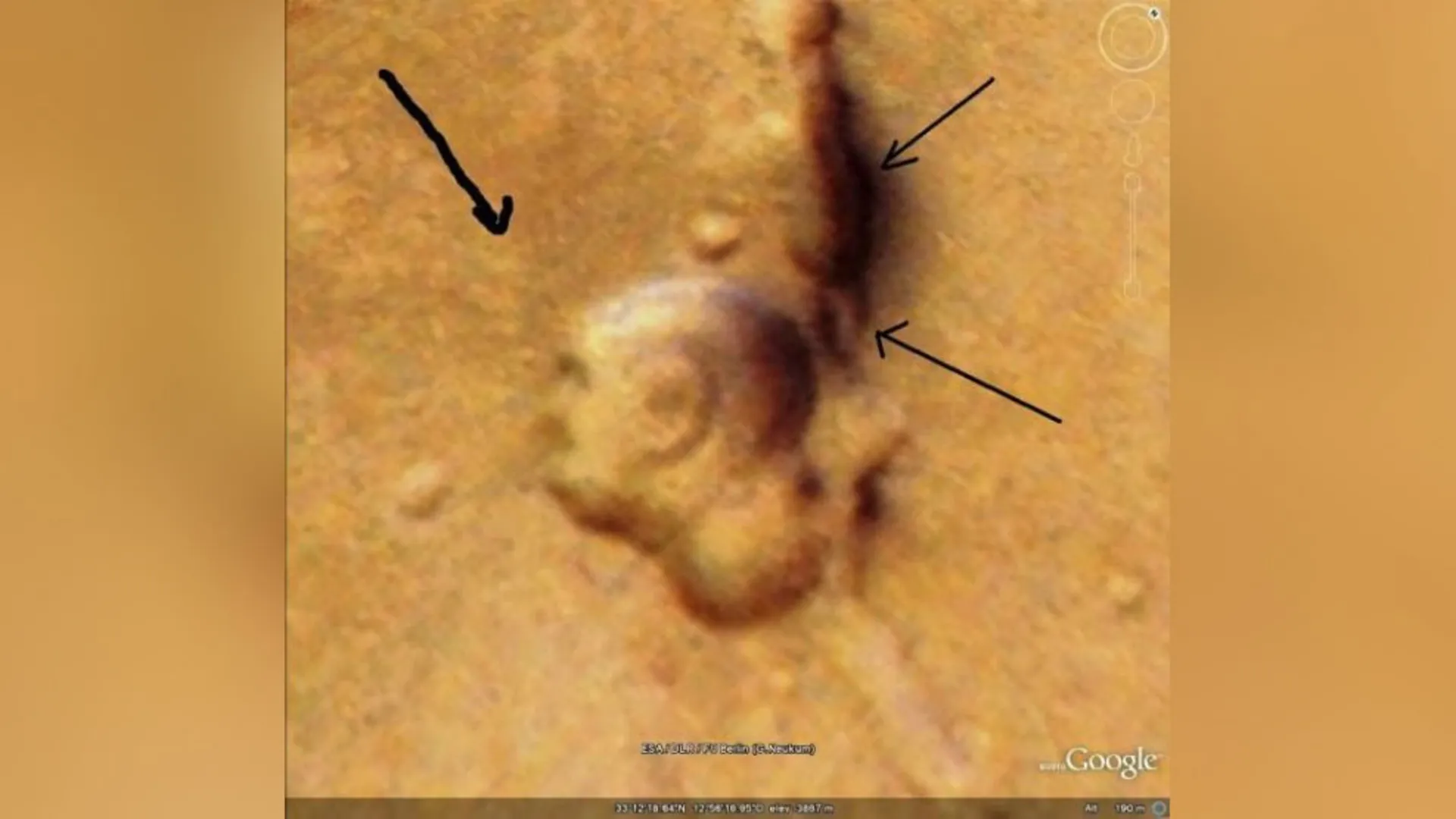
Alpha biological station
In 2011, another piece of evidence for the claim of life on Mars was unveiled. In a viral video on YouTube, someone claimed to have detected a human (extraterrestrial) base on Mars. He called this base “Alpha Biological Station”. Through Google Mars, he identified a linear and mysterious structure on the surface of the red planet.
Astronomers immediately identified a white structure that had become pixelated and of poor quality. This image was created due to the accumulation of cosmic rays in the image sensor of the camera that recorded this image. Alfred Ekayon, a planetary scientist at the Planetary and Lunar Laboratory of the University of Arizona and the head of the Planetary Image Processing Research Laboratory, says this: Such effects are common in space images taken by orbiting telescopes outside the magnetosphere.

The image received by the European Space Agency (ESA) orbiter in 2019 looks like a giant blue-haired spider with its feet on a Martian mountain. The reality is much more interesting. The legs of this spider are actually the paths of hundreds of small tornadoes or devil’s ovens. It is not yet clear why this mountain is the center of tornadoes; But according to ESA scientists, the movement of air masses in this area can lead to the formation of such tornadoes.

Martian beetle
It seems that seeing creepy crawlies on Mars has become a hot topic. In 2019, William Romoser, professor emeritus, made an interesting claim. He claimed to have seen cockroaches and other insects and even reptiles on the surface of Mars. After examining the images received from NASA’s Mars rovers, Romoser observed raised shapes and vague ovals on the surface of Mars; But this time, Paridolia tricked him; Because the protruding shapes were mostly stones.
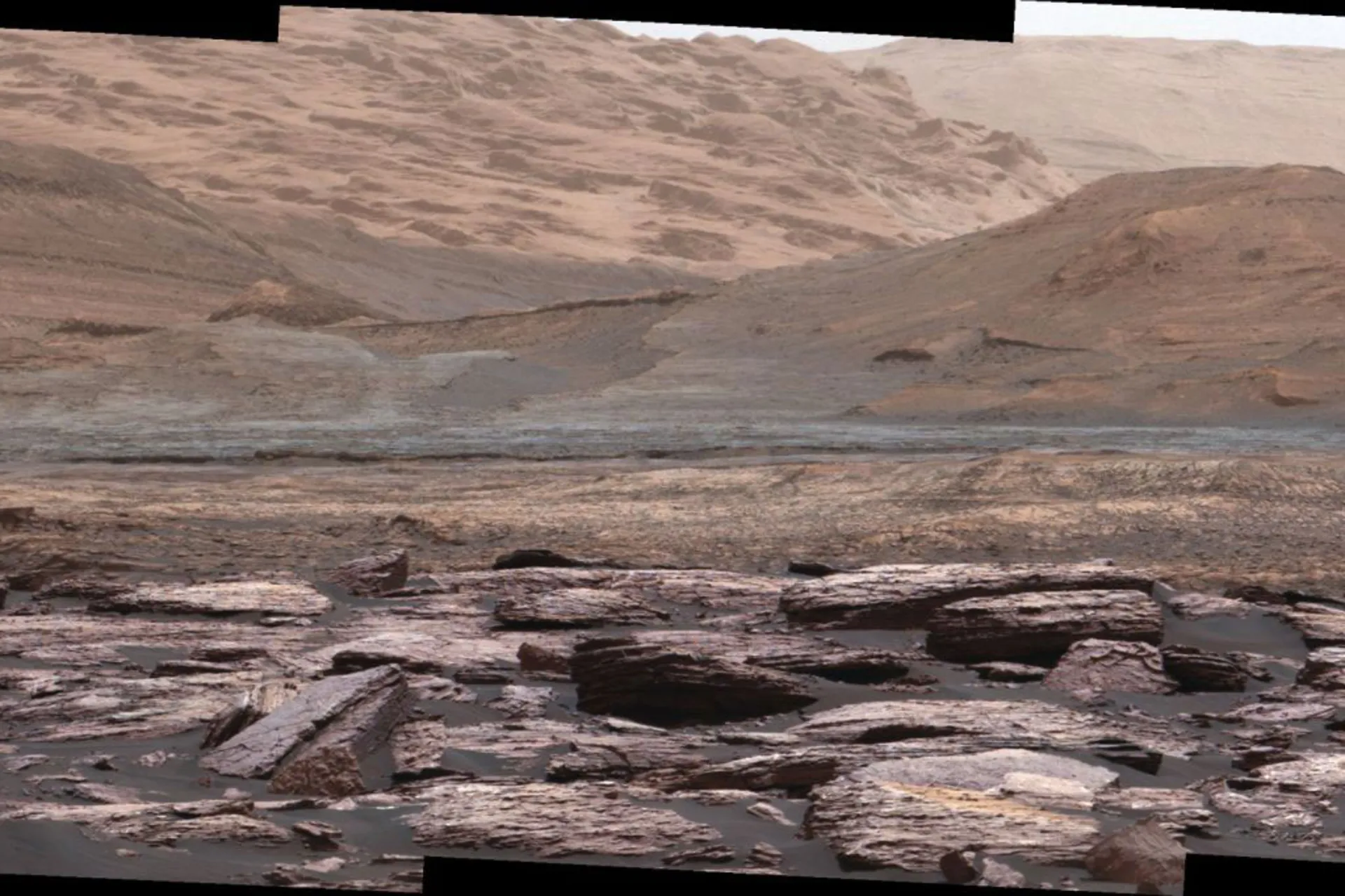
Big discharge
Between July and September 2019, an object, possibly a meteorite or part of a comet, collided with the southern ice cap of Mars, puncturing a thin layer of the ice cap, and releasing red soil from the crater. The result of this incident was the emergence of a large red discharge that resembled cartoon characters hitting the wall. The large HiRISE (High Resolution Imaging Science Instrument) camera on the Mars Reconnaissance Orbiter (MRO) captured the leak, which is up to a kilometer across. This discharge was not a vision error and was completely fixed.
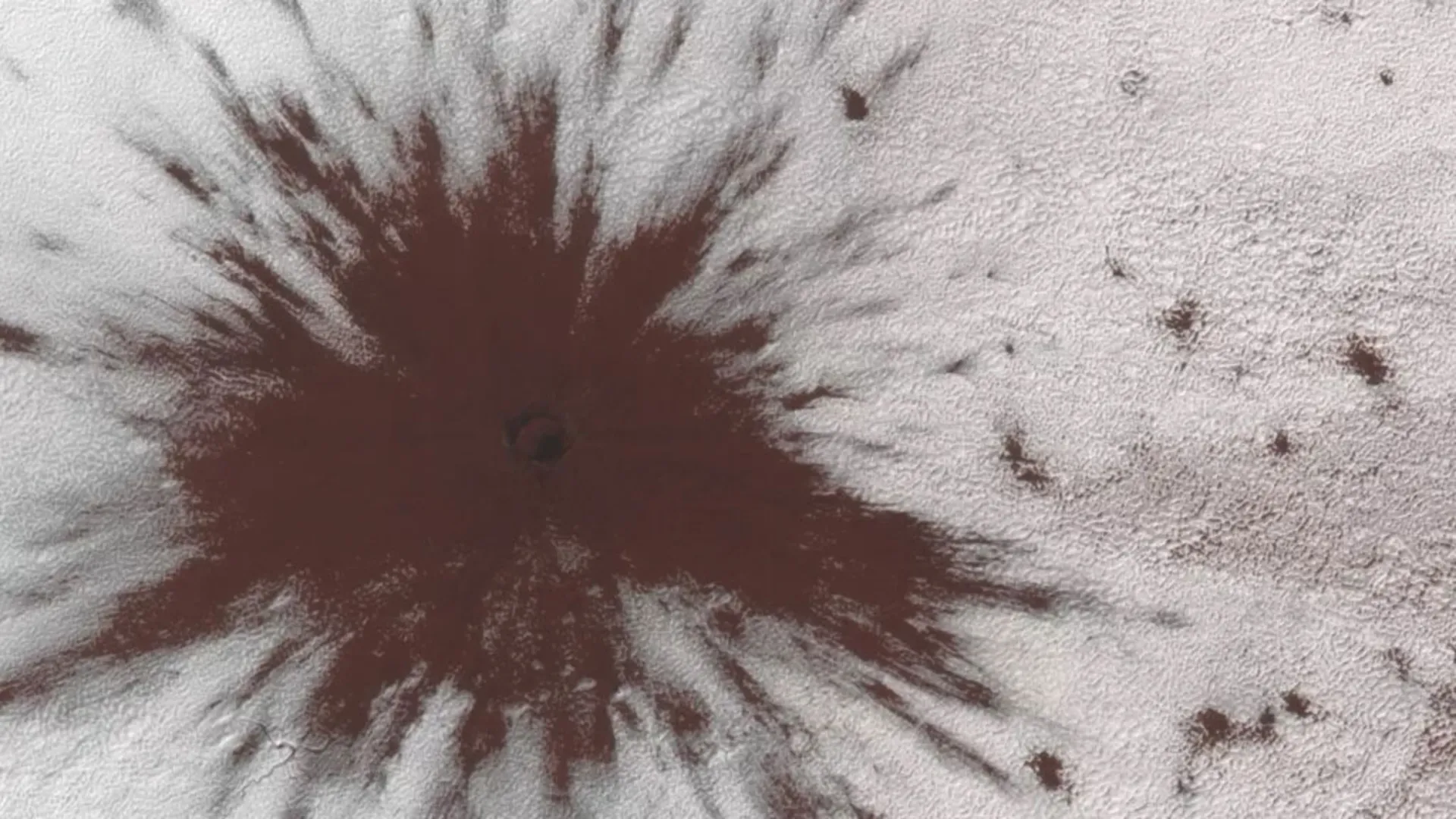
Strange green stone
As you know, Mars is a red planet; But what is this strange green stone (pictured below) doing on the red planet? The Perseverance probe captured the image of this rock. The length of this stone reaches approximately 15 cm and it is located in the impact crater of Yezro, which is close to the landing site of Perseverance. The Perseverance rover removed a portion of the rock to vaporize it. The rover’s cameras and spectrometers examined the resulting vapor cloud to reveal its chemical composition. The answer to this mystery will be revealed soon.
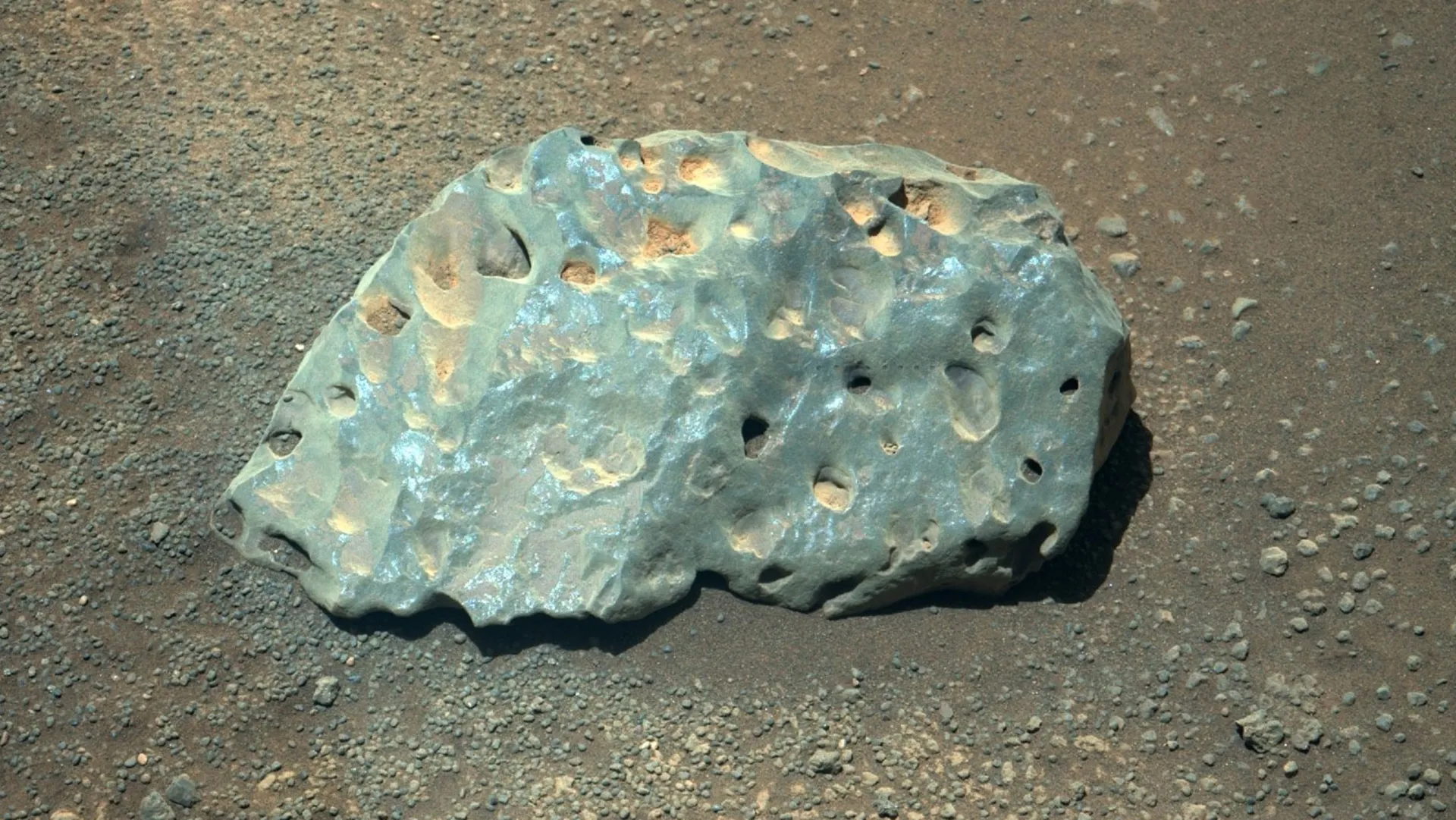
Observations and explorations of the planet Mars
Throughout history, Mars has only been observable at the closest distance to Earth. Martian perigee positions (closest to Earth) occur every 15 to 17 years. In the 17th century, Tycho Brahe measured the relative distance between Earth and Mars. The Cassini probe made more measurements. In 1610, Galileo was able to observe Mars with a telescope for the first time. Christian Huygens was also the first person to draw a map of the surface features of Mars. During the 20th century, with the beginning of the space age, observations and explorations increased at a remarkable rate.
So far, many probes have been sent to Mars, but almost one out of three missions were successful. In general, exploration programs pursue four main goals:
- Investigating the existence of Martian life
- Investigating the Martian climate
- Survey of Martian geology
- Preparing for human exploration
In the first Mars missions, which were simply flybys of the planet, spacecraft flew close to the surface of Mars and imaged it. NASA’s Mariner spacecraft was a small robotic probe developed to study the neighboring planets, including Venus, Mars, and Mercury. Mariner 4 passed by Mars in July 1965 and sent the first pictures of this alien world to Earth.
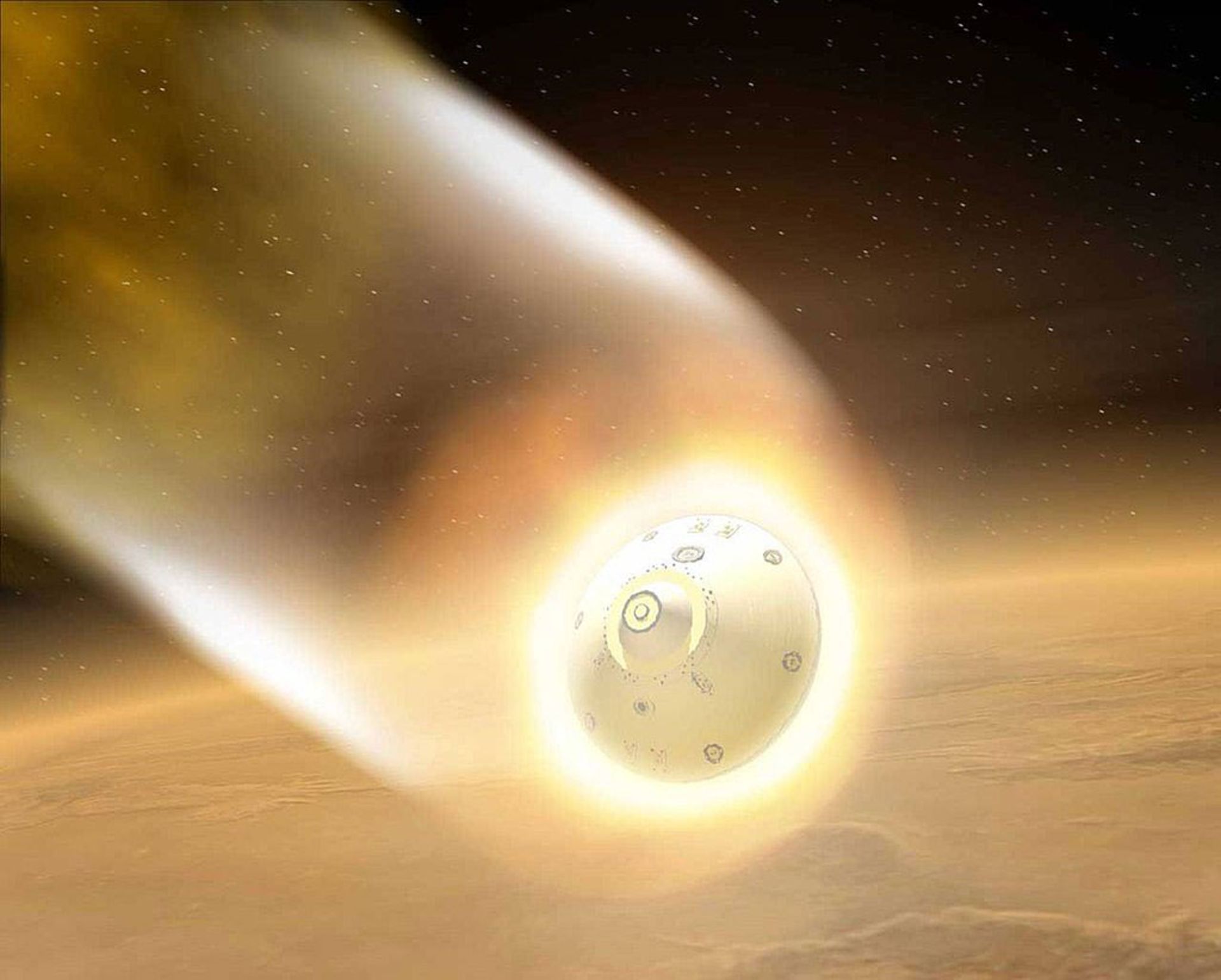
The thin atmosphere of Mars makes it difficult for probes to land
In 1971, the Soviet Union managed to send its first spacecraft into Mars orbit and even sent a lander to touch its surface. The Mars 3 Orbiter also sent back data about the topography, climate, atmosphere, and geology of Mars for eight months. Although the lander of this probe managed to land on the surface of Mars, it lasted only 20 seconds.
Later, the Mariner 9 orbiter sent back more and more detailed images of the Martian atmosphere, mapping its surface, revealing the Martian topography, and capturing many images of this remote and strange world. The above missions solved some mysteries of Mars, including the legend of Martian canals and its ancient civilizations. On the other hand, they raised new questions about ancient Martian riverbeds that could indicate the presence of liquid water on this planet.
The Viking 1 and 2 spacecraft were a pair of orbiters and landers that reached Mars in 1976. These two probes continued to operate until the end of 1982 and surprised scientists by sending images of the surface of Mars. The Viking landers conducted biological experiments on the Martian soil and were supposed to find signs of life, but their results were not enough.
The thin atmosphere of Mars makes it difficult to land on the surface of this planet
The Mars Rover mission launched in 1996 paved the way for sending rovers. Sojourner, the rover of this spacecraft, sent information about the seasonal changes and weather of Mars, especially dust storms. The Mars Global Surveyor spacecraft has been in orbit since March 1999 with the aim of studying the surface of Mars.
The long-duration mission has provided new data on Mars’ changing seasons and weather, including dust storms. Mars Odyssey orbiter entered Mars orbit in 2001. The gamma-ray spectrometer of this spacecraft managed to discover significant amounts of hydrogen gas within a few meters of the surface of Mars.
The European Space Agency went to Mars in 2003 with the Mars Express probe. This probe was carrying a surface lander called Beagle 2, which disappeared in 2004. Beagle 2 was rediscovered in January 2015 by NASA’s Mars Reconnaissance Orbiter (MRO). During its mission, the Mars Express orbiter managed to discover methane in the Martian atmosphere, which is one of the necessary elements for the formation of life.
In January 2004, NASA landed its twin Mars rovers Sprite and Apchornity on the surface of Mars. Perhaps the most famous Mars missions are the Spirit and Opportunity rovers. These two rovers landed on both sides of Mars in January 2004 and began their extensive mission.
These two rovers examined several kilometers of the Martian soil and sent more than 100,000 high-quality images. They examined Martian rocks and soil and used laboratory modules equipped for geological tests on the Martian surface and subsurface. The mission of these two rovers was designed for 90 days, but they lasted for several years. The Spirit rover was active until 2010, and the Opportunity rover was shut down for good in 2018.
On March 10, 2006, the MRO (Mars Reconnaissance Orbiter) probe entered Mars orbit for two years of exploration. The orbiter began mapping the Martian surface and its climate with the aim of finding suitable landing sites for future missions. The MSL (Mars Science Laboratory) mission was launched on November 26, 2011 to send the Curiosity rover to the surface of Mars. This rover reached Mars on August 6, 2012. Curiosity is more advanced and larger than NASA’s previous rovers, and its maximum speed reaches 140 meters per hour. The rover’s experiments included laser chemical sampling and sending data on the composition of rocks.
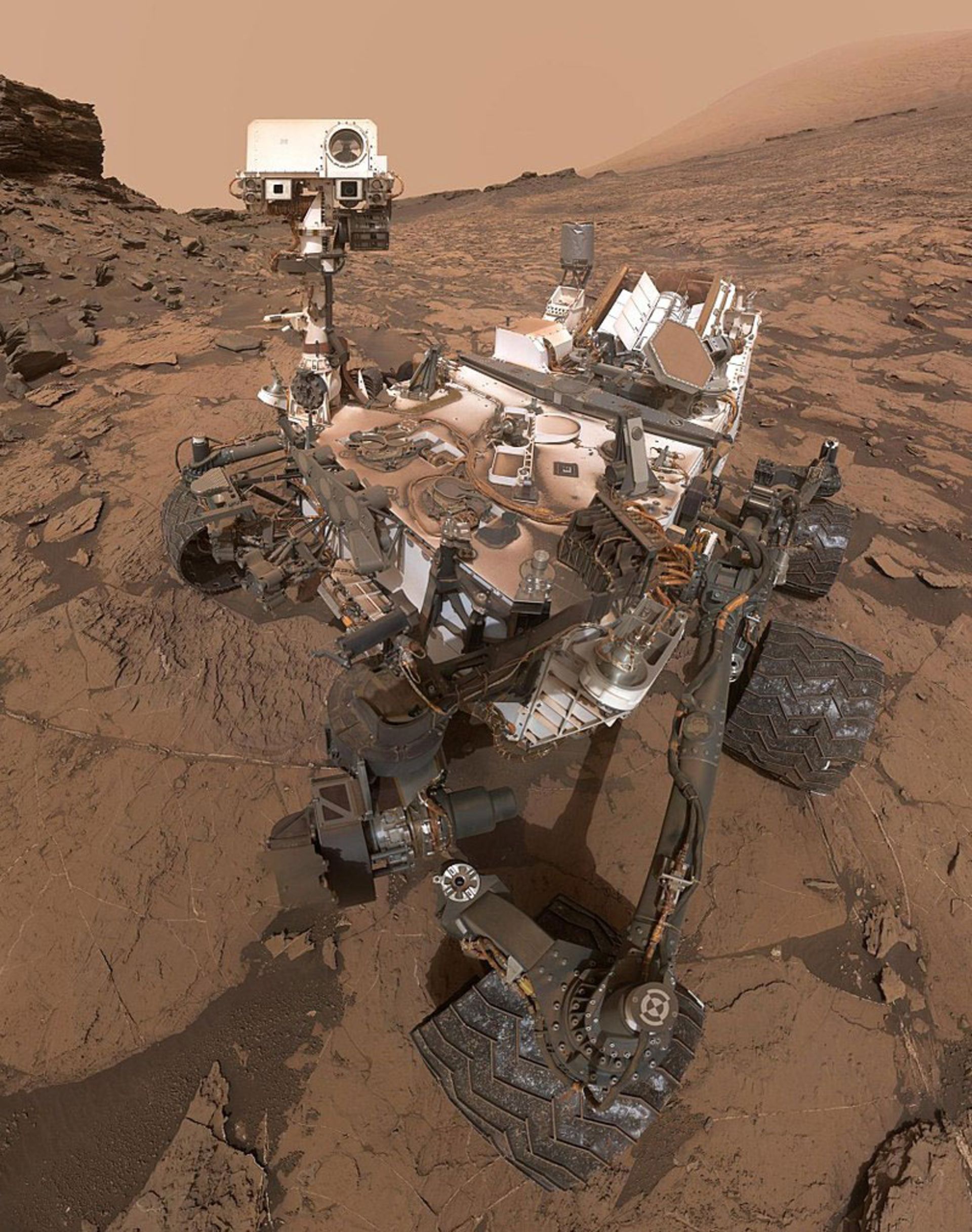
Selfie probe Curiosity
The MAVEN orbiter was launched on November 18, 2013, and landed at an altitude of 6,200 km on September 22, 2014, to study the Martian atmosphere. The goals of this mission include investigating the atmosphere and water of Mars in the distant past. The Indian Space Research Organization (ISRO) launched the MOM (Mars Orbiting Mission) spacecraft on November 5, 2013. This spacecraft was placed in Mars orbit on September 24, 2014. ISRO is the fourth space agency to reach Mars after the Soviet Union, NASA, and the European Space Agency.
The TGO orbiter reached Mars from Exomars in March 2016. Schiaparelli’s lander landed on Mars as an experiment. Schiaparelli hit the Martian surface but sent back key data about the parachute landing, so the test can be considered a partial success.
The second part of this mission is the Rosalind Franklin Rover. This rover was supposed to be launched in July 2020, but its launch was postponed until 2022. Following Russia’s invasion of Ukraine, the European Union, along with the United States, announced a list of new restrictive sanctions against Russia. According to the European Union, these sanctions cover the fields of finance, energy, transportation, technology, and passport issuance. Issa noted that he is complying with the sanctions. The organization wrote in its update:
We fully implement the sanctions imposed by our member states against Russia and evaluate the consequences of our current programs that are carried out in cooperation with the Russian Space Agency. In addition, we align our decisions in close coordination with industrial and international partners (especially with NASA and in the International Space Station program) and the decisions of the member countries of the organization.
Dmitry Rogozin, the head of Russia’s space agency, reacted quickly on Twitter, claiming that Isa was self-harming out of anger. If ExoMars is not launched in 2022, it will have to wait another two years until the next opportunity; Because it is only at that time that Mars and Earth are in the closest position to each other. In August 2012, NASA selected the $425 million InSight lander to explore the depths of the Martian surface. Two CubeSats named MarCO were launched together with InSight on May 5, 2018. The CubeSats separated 1.5 hours after launch and started their paths. The InSight probe successfully landed on the surface of Mars on November 26, 2018.
Perseverance mission
The Perseverance rover was launched from the Mars 2020 mission on July 30, 2020. This probe landed on the surface of Mars on February 18, 2021. Perseverance was also accompanied by a helicopter named Ingenuity. Twelve months later, Perseverance reached the mouth of Yezro, 45 km away. Based on the topography, it is clear that more than three billion years ago, Yezero was a body of water the same size as Lake Tahoe in America, and rivers flowed from the west and east of it. One of Perseverance’s first missions was to launch Ingenuity, a small robotic helicopter. Ingenuity is the first spacecraft to lift off from the surface of another planet. Perseverance also demonstrated the performance of oxygen generation technology, which is essential for manned missions to Mars.
In the next step, Perseverance investigated the bed of the Yazoro crater and it was found that the rocks of this crater are far from the expectations of scientists. Perseverance had trouble collecting stone cores several times. The rover will mine rock material in cylinders about the size of chalkboard chalk that will be returned to Earth on future missions. Ingenuity was one of the last additional parts of the mission, which was intended to prove the feasibility of flying in the thin air of Mars. On April 18, 2021, Igneoti soared to a height of three meters, flew for 30 seconds, and then returned to the ground. This flight lasted a total of 39.1 seconds.
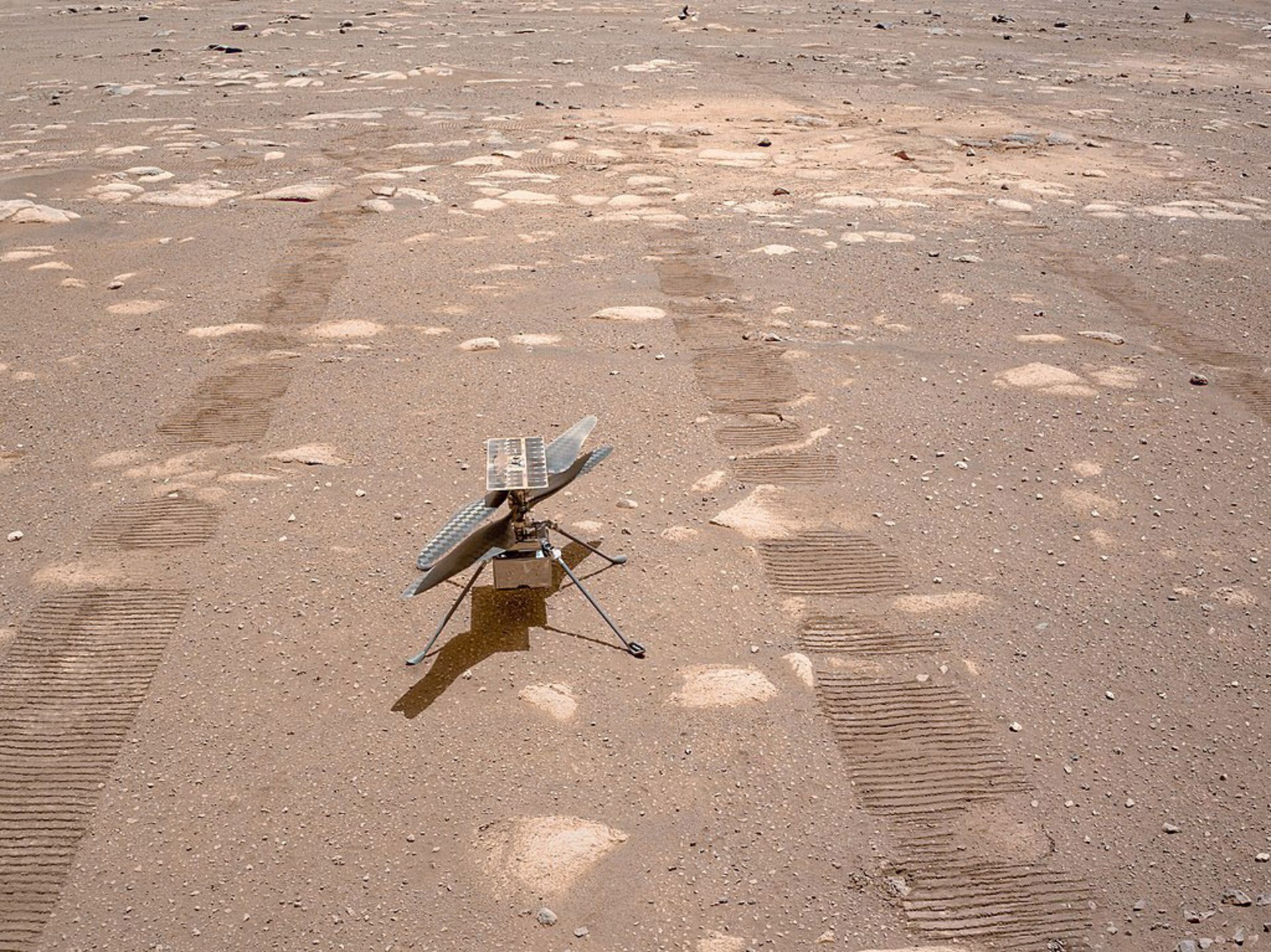
The Ingenuity helicopter is preparing for its first flight.
Ingenuity’s mission was supposed to end after four flights; because Perseverance should have abandoned it and continued scientific research; But NASA decided that five flights were not enough. As Perseverance began exploring the rocks to the south, Ingenuity’s helicopter accompanied it and surveyed the terrain ahead of the rover. Thus, the rover’s time is not wasted by hitting unexpected rocks.
Perseverance surprised scientists by examining and excavating rock samples south of its landing site. Perseverance’s instruments to examine the materials that makeup Martian rocks examine their tiny grains, which are as small as a grain of sand. The cameras on the robotic arm can also record close-up images. In the observations, large olivine particles were seen; An igneous rock mineral that can accumulate in the bed of a large lava flow. Other pieces appeared between the olivine particles that were filled with carbonate; A mineral that is formed by reacting with water.
Perseverance is the first step of mankind in realizing the dream of bringing Mars samples to Earth. This probe creates holes in the rocks and holds them in insulated pipes. Since Perseverance has no way to send rock samples back to Earth, another spacecraft will have to send them home later. This mission is called “Mars Sample Return” and is a joint project of NASA and the European Space Agency.

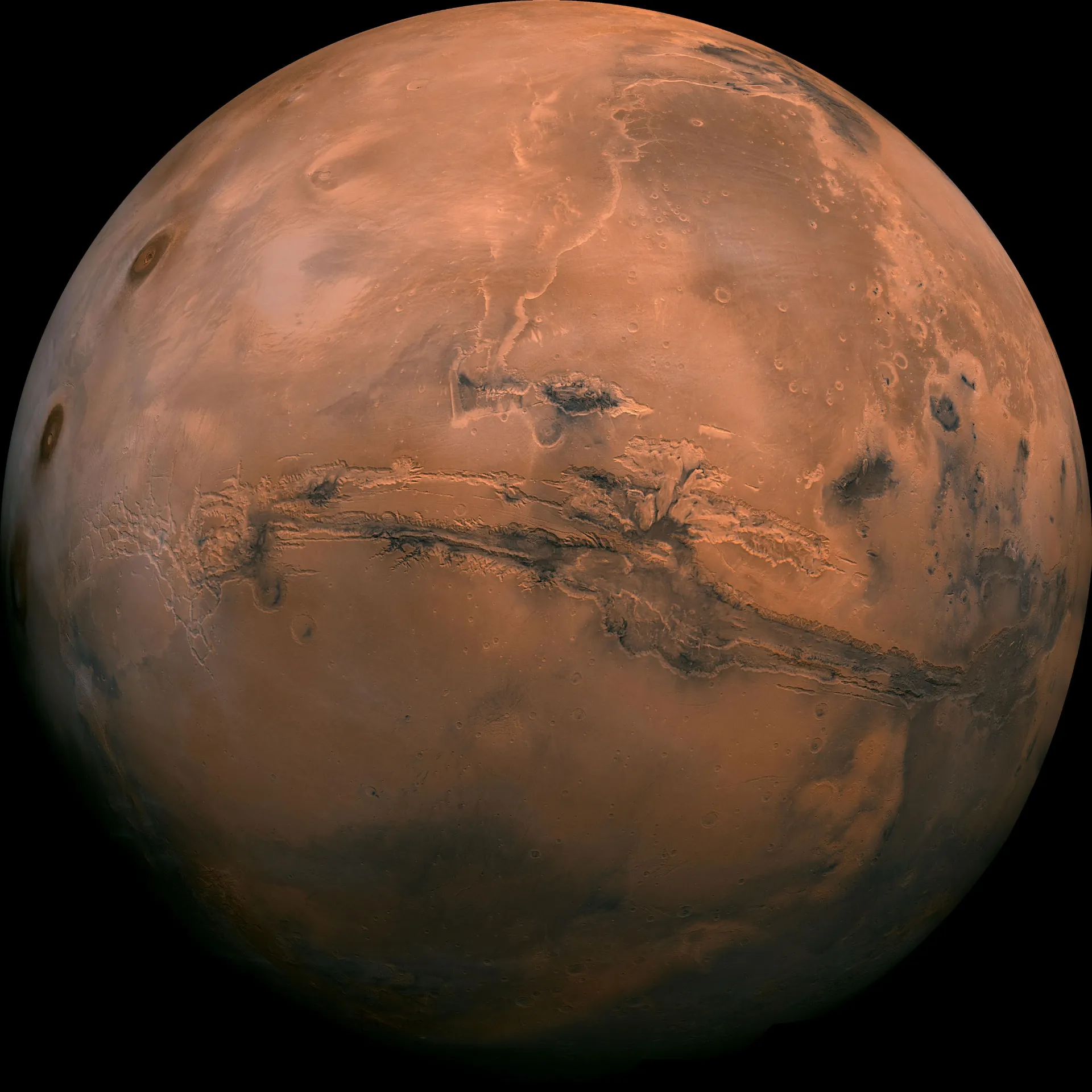
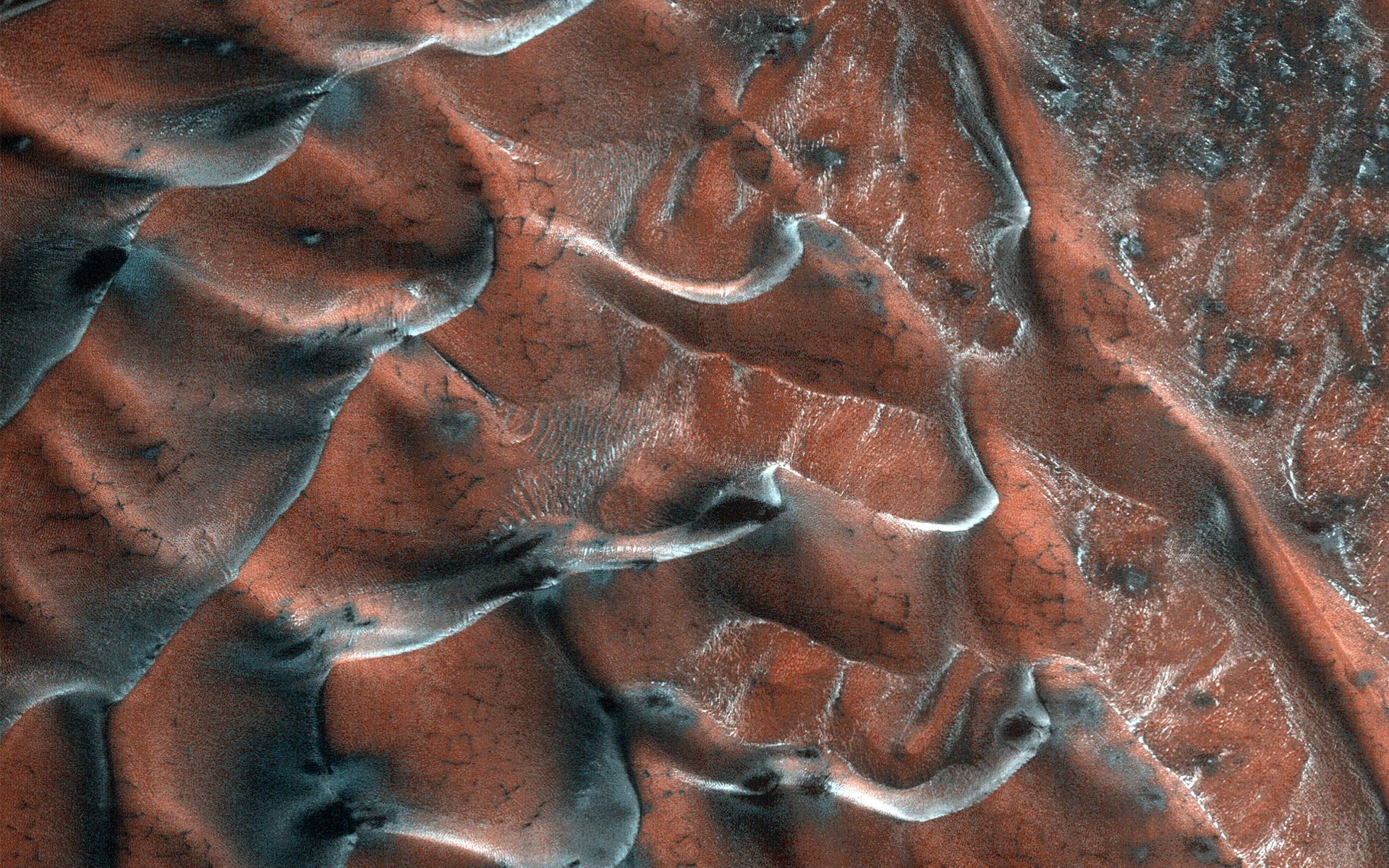
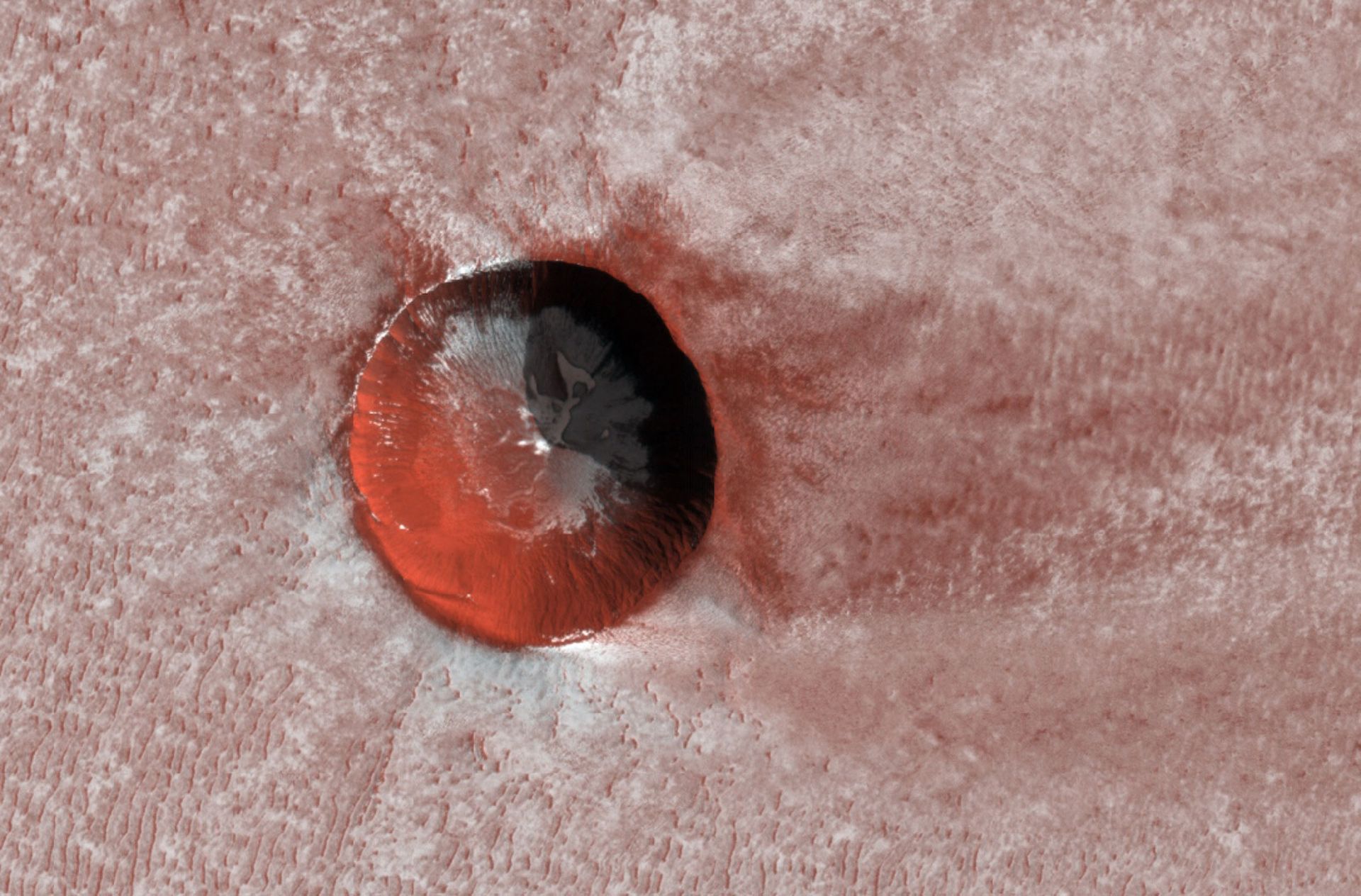
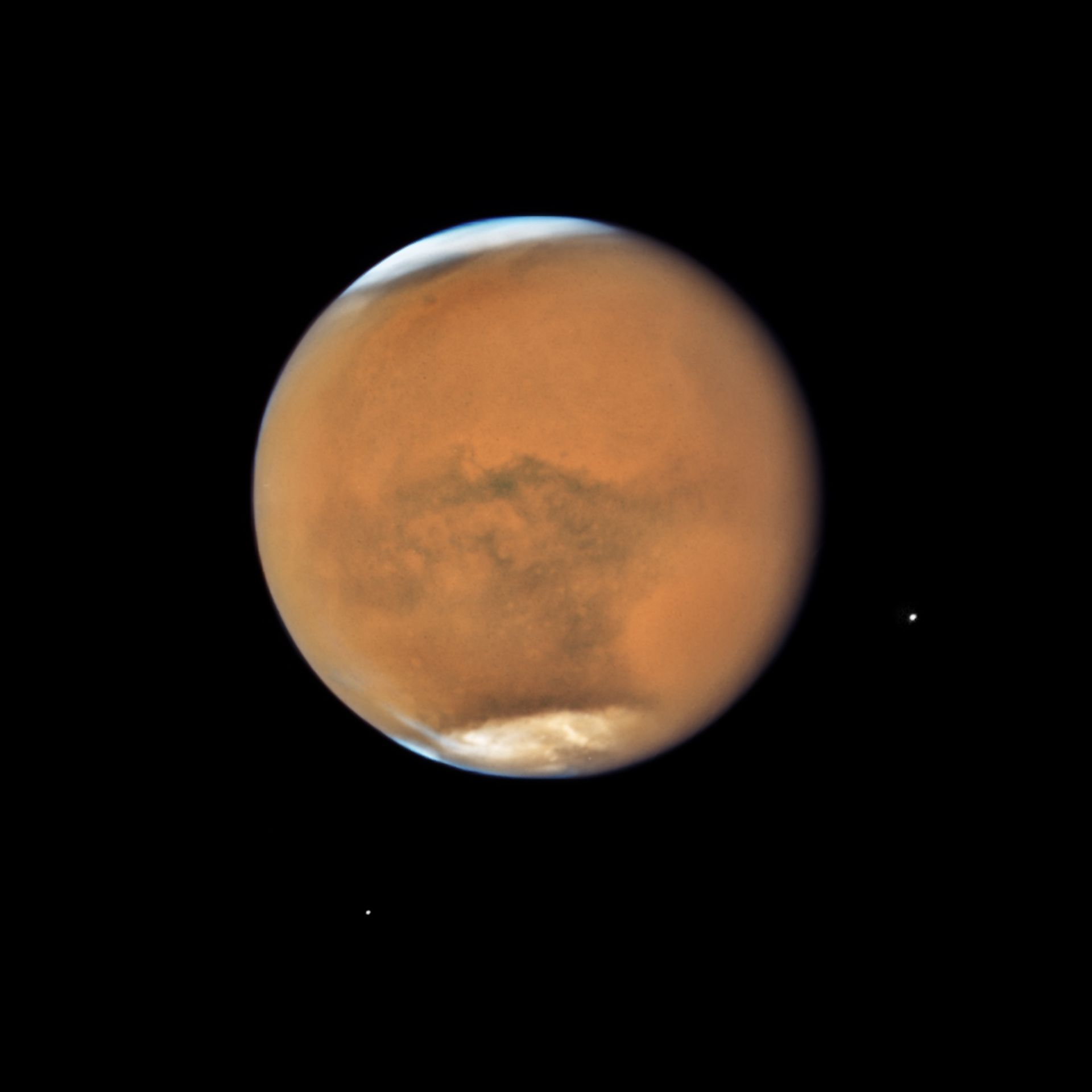
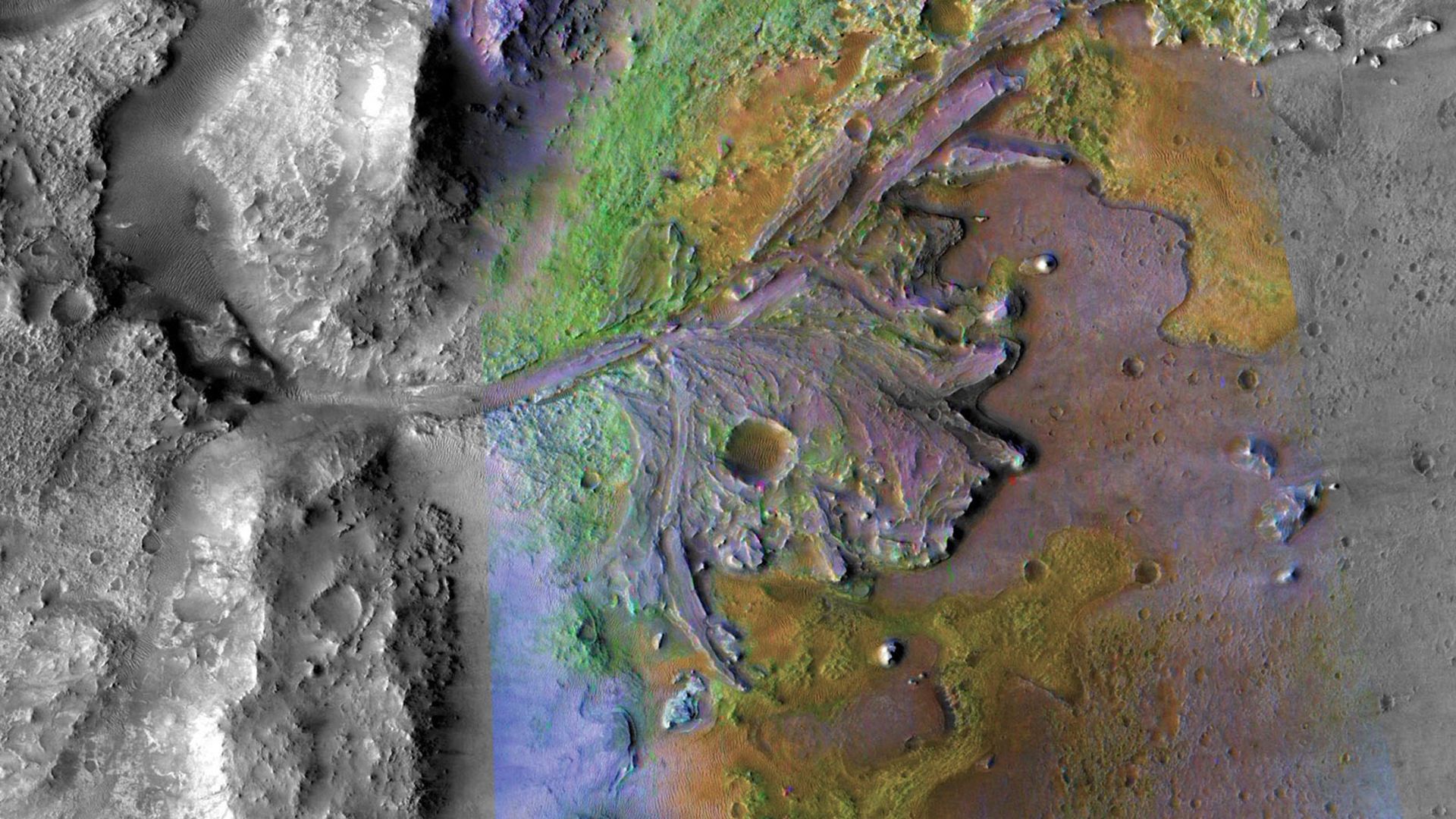
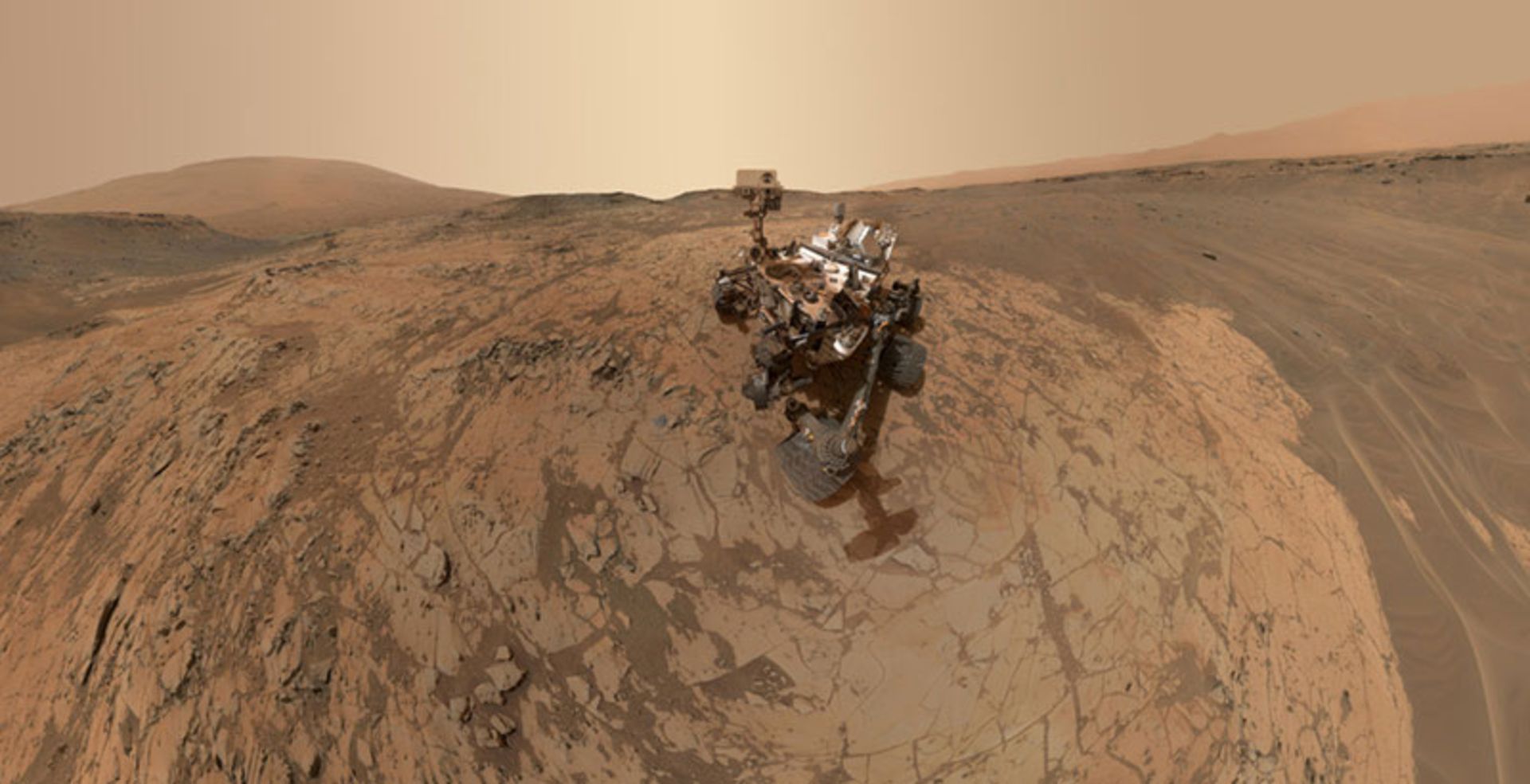
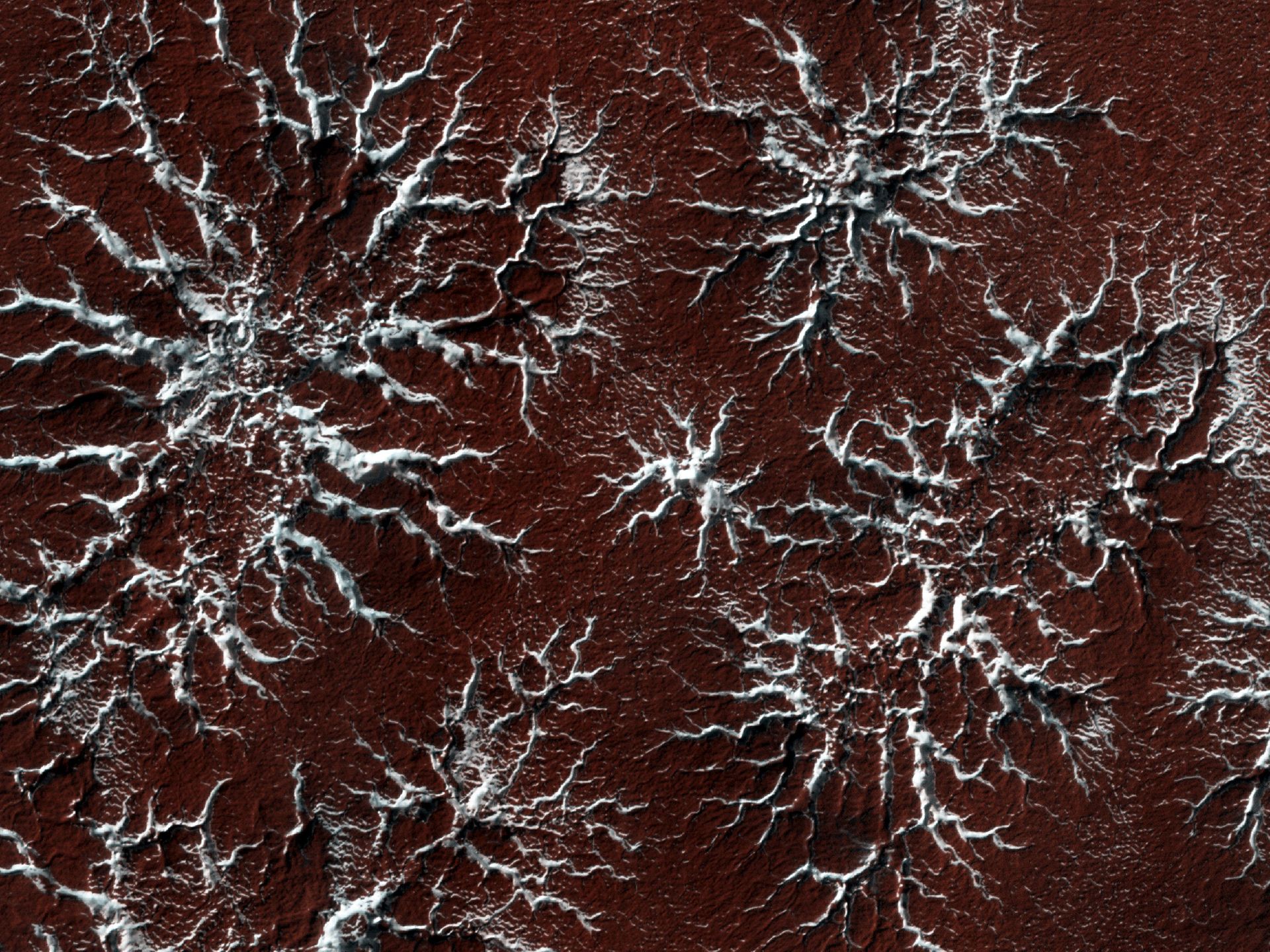
Image gallery of Mars exploration missions
Manned missions
Human exploration of Mars has had many supporters since the early days of the space age. Robert H. Goddard used the idea of a trip to Mars as an incentive to study physics and aerospace engineering. Various proposals for human exploration of Mars have been presented throughout the history of the space age. Currently, active plans and programs to send humans to Mars in the next ten to thirty years have been presented at the government and private levels.
NASA
In 2004, the then President of the United States, George W. Bush, announced the program of human exploration of Mars. Urine spacecraft will be used to send space crews to the moon by mid-2020. In the next phase, the moon will become a way station for the journey to Mars. On September 28, 2007, then NASA administrator Michael D. Griffin announced that he would send humans to Mars by 2037. On October 8, 2015, NASA released the official plan for Mars exploration and colonization. They named this project “Journey to Mars”. This plan has three stages to sustainable colonization.
- The first phase that is being implemented is called the “ground-dependent” phase. At this stage, until 2024, the International Space Station will be used to evaluate technologies and investigate the effects of long-duration space missions on the human body.
- In the second stage, titled “Proof Field”, the dependence on the Earth will be removed and for most of the tasks, the space of Cis Luna (Moon orbit to the surface of the Moon) will be used.
- The final phase, the “Earth-independent phase,” involves long-duration missions to the lunar surface. At this stage, the resources of Mars are used for fuel, water, and building materials. NASA’s goal is to send humans to Mars by the mid-2030s, although independence from Earth may be a little later.
SpaceX
The long-term goal of the private company SpaceX is to plan space flights to Mars and colonize the planet. To achieve this goal, this company is developing a spacecraft called Starship, which is capable of transporting crew to Mars and other solar system objects. In 2017, SpaceX announced plans to send two unmanned starships to Mars by 2022, followed by two more unmanned and manned starships in 2024. Starship is supposed to carry at least 100 tons of cargo.

Starship SN15 and SN16
The impact of travel to Mars on humans
Mars is a harsh environment for human life. In the long term, various technologies have been developed to aid long-term space exploration, and these technologies may be used for Mars as well. The longest duration of human stay in space is 438 days recorded by Valery Pliakov. The longest time spent outside Earth’s Van Allen Belt is about 12 days, dating back to the Apollo 17 moon landing. This period is very short compared to NASA’s 1,100-day journey in the next decade. On the other hand, according to scientists, traveling to Mars will have harmful biological effects on the human body. Due to the high radiation, the physical effects of living on Mars are increased.
Many missions to Mars are being developed and planned that will pave the way for human travel. Scientists hope the robotic probes will send back data about underground activity as well as the geology of Mars and take samples. Such missions could discover more signs of life and water on the planet. Maybe life is hidden under the layers of the Martian surface.


You may like
-

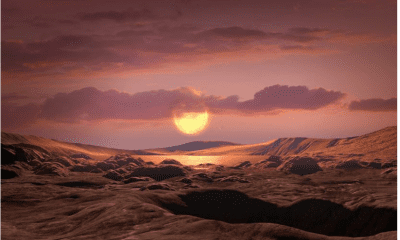


Most alien planets probably do not have day or night
-




The biography of Edwin Hubble
-

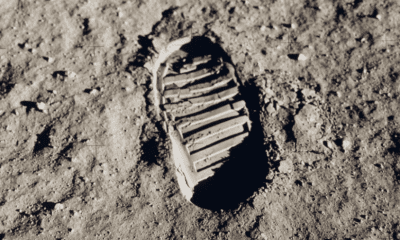


Can telescopes see astronaut footprints on the moon?
-




Can you really see the Great Wall of China from space?
-

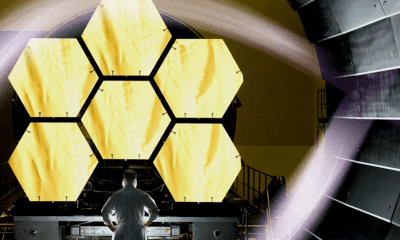


The James Webb Space Telescope; A look at the vastness of the universe
-

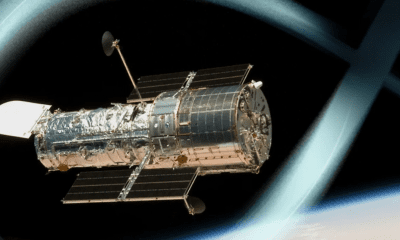


Hubble Space Telescope; A portal to the mysterious depths of the universe


Most alien planets probably do not have day or night
Do aliens sleep? You may take sleep for granted, but research suggests that many possible life-hosting planets may not have a day-night cycle. It is difficult to imagine the absence of day and night, but right now on Earth there are creatures living in lightless habitats in the depths or on the seabed, and they offer a vision of alien life without the existence of a circadian rhythm.
There are billions of potentially habitable planets in our galaxy; But how do we get to this number? The Milky Way has between 100 billion and 400 billion stars, seventy percent of which are cold and small red dwarf stars or M dwarfs.
According to a detailed survey of exoplanets in 2013, approximately 41% of red dwarf stars have a planet in their life belt. At this distance, the planet has the right temperature to support liquid water; Therefore, these planets have the potential to host liquid water.
We still do not know which of the discovered exoplanets have liquid water. However, 28.7 billion planets are only in the red dwarf life belt. We have not even considered the statistics of other types of stars like our sun.
 Planets close to red dwarfs are fatally locked to their star
Planets close to red dwarfs are fatally locked to their star
Rocky planets in the habitable belt of an M dwarf are called M Earths. M-Earths are fundamentally different from our Earth. One difference is that M dwarf stars are much cooler than our Sun. Also, M Earths are located at a close distance from their star, and for this reason, the gravitational influence of the star on them is strong.
The star’s gravity exerts a stronger force on the near side of the planet than on the far side. By creating friction, the planet’s rotation slows down until its orbital and translational rotations become synchronized over millions of years. Thus, M fields are likely to be deadlocked; So that one hemisphere of them is always facing the star and the other hemisphere is always behind it.
The year of a mortally locked planet is as long as its day. Earth’s moon also has a deadly lock on us. For this reason, we always see one side of it and cannot observe its hidden side.
A planet in mortal lock looks strange, But most possible habitable planets are of this type. Our nearest planetary neighbor, Proxima Centauri b, located in the Alpha Centauri system four light-years from Earth, is likely a fatally locked M-Earth.
As a result, unlike our Earth, M Earths have no day or night and even seasons; But terrestrial life, from bacteria to humans, has circadian rhythms corresponding to the day and night cycle. Sleep is one of the most obvious consequences of circadian rhythm.
On Earth, some creatures live in absolute darkness
The circadian cycle affects biochemistry, body temperature, cell regeneration, behavior, and much more. For example, people who are vaccinated in the morning produce more antibodies than people who are vaccinated in the afternoon; Because the response of the immune system is different during the day.
We cannot yet say with certainty how much periods of inactivity and regeneration affect life. Perhaps organisms that evolved without cyclical time never needed to rest.
If you doubt it, you can look at terrestrial organisms such as cave dwellers, deep sea life, and microscopic organisms in dark environments such as the earth’s crust and the human body that thrive in space away from daylight.
Many life forms have biological rhythms that are synchronized to stimuli other than light. Naked burrowing mice spend their entire lives underground and never see the sun, But their day and night hours are proportional to the daily and seasonal cycles of temperature and rainfall. Also, deep-sea bivalves and thermal well shrimps coordinate with ocean tides.
Bacteria that live in the human gut synchronize with melatonin fluctuations in the host’s body. Melatonin is a hormone in the body that is produced in response to darkness. Temperature changes that occur in thermal wells, humidity fluctuations chemical changes, and environmental currents can all cause biological fluctuations in the body of living organisms.
According to new research, M-Earths can have alternate cycles for days and seasons. To evaluate days and seasons on exoplanets, scientists have adapted climate models to simulate the environment of M-Earths and planets such as Proxima Centauri b.
According to the simulations, the contrast between the night and day sides of the planets produces gusts and atmospheric currents similar to Earth’s gust currents. If a planet has water, its dayside is likely to have thick thunderclouds.
The interaction between winds, atmospheric waves, and clouds can change the climate and produce regular cycles of temperature, humidity, and rainfall. The length of these cycles varies from hundreds to thousands of Earth days depending on the state of the planet, But it has nothing to do with the rotation period of the planet. Although the stars in the sky of these planets remain constant, the environment changes.
Perhaps life on M-Earths evolved to match biological rhythms and climatic cycles, or perhaps evolution arrived at a more exotic solution. One can imagine species that live on the day side of the planet going to the night side to rest and regenerate themselves.
These descriptions remind us that if life is out there, it can challenge assumptions we don’t know exist. The only certainty is that it will surprise us.


nameNoun: Any nounal word or phrase which indicates a particular person, place, class, or thing.
Noun: reputation.
Noun: An abusive or insulting epithet.
Noun: A person (or legal person).
Noun: Those of a certain name; a race; a family.
Noun: authority; behalf.
Noun: A unique identifier, generally a string of characters.
Noun: An investor in Lloyd’s of London bearing unlimited liability.
Verb: To give a name to.
Verb: To mention, specify.
Verb: To identify as relevant or important
Verb: To publicly implicate by name.
Verb: To disclose the name of.
Verb: To designate for a role.
Verb: To initiate a process to temporarily remove a member of parliament who is breaking the rules of conduct.
Noun: Any of several types of true yam () used in Caribbean Spanish cooking.
SProper noun: in which several of the axioms of ZF are derivable as theorems.
Noun: Any nounal word or phrase which indicates a particular person, place, class, or thing.
Noun: reputation.
Noun: An abusive or insulting epithet.
Noun: A person (or legal person).
Noun: Those of a certain name; a race; a family.
Noun: authority; behalf.
Noun: A unique identifier, generally a string of characters.
Noun: An investor in Lloyd’s of London bearing unlimited liability.
Verb: To give a name to.
Verb: To mention, specify.
Verb: To identify as relevant or important
Verb: To publicly implicate by name.
Verb: To disclose the name of.
Verb: To designate for a role.
Verb: To initiate a process to temporarily remove a member of parliament who is breaking the rules of conduct.
Noun: Any of several types of true yam () used in Caribbean Spanish cooking.
The biography of Edwin Hubble, the legendary astronomer who discovered the extragalactic space
Edwin Powell Hubble known as Edwin Hubble was a famous American astronomer who played an important role in formulating the basic principles of extragalactic and observational astronomy. Historians and astronomy experts consider him one of the most important astronomers in history. Hubble placed the space clouds, which before her time were known as gas and dust particles and were in the category of nebula or nebula, in the category of galaxies.. Historians consider Hubble’s discovery of other galaxies equal to Copernicus’ theory in terms of scientific value. Copernicus proved that the Earth is not at the center of the solar system, and Hubble proved that the Milky Way is not the center of the universe.
One of the important scientific relics of this astronomer is Hubble’s law in space. In short, this law states that the universe is expanding at a constant rate. In addition, in this law, the distance of each galaxy from the edge of the universe is directly proportional to its speed. Of course, this law was discovered two years before Hubble’s presentation by Georges Lemaitre, but its fame came to Hubble. The Hubble telescope is one of the most famous monuments built in the name of this legendary astronomer. An example of this telescope is installed in his hometown of Marshfield, Missouri. This telescope was sent into Earth orbit in 1990 to capture more detailed images of space outside the Milky Way.
Edwin Hubble has another great achievement in the field of cosmology and that is the classification of galaxies. This classification has been used by astronomers for many years. Hubble played a significant role in adding the astronomy category to the Nobel Prize. Of course, the sudden death of this scientist in 1953 prevented him from receiving this award.

Birth and education
Edwin Hubbell was born on November 20, 1889, in Marshfield, Missouri. His mother was Virginia Lee James and his father was John Powell Hubble. His father was a lawyer and insurance businessman. Edwin was the third child out of 8 children in this family. Of course, like many children of those years, some of Edwin’s siblings died in childhood.
Hubbell lived in a rich family that had to migrate many times because of his father’s work style. During these trips, which were generally in cities around Chicago and Illinois, they lived in luxurious houses with many servants. The children of the Hubble family were all brought up with work and responsibility; Because their parents believed that this style of upbringing would increase their sense of responsibility.
Edwin Hubble was very interested in sports as a child and teenager
As a child, Edwin struggled to keep up with his older siblings and students, so he learned to read before school. He was very fond of adventure books by Jules Verne and H. Rider Haggard. Edwin’s grandfather was an amateur but enthusiastic astronomer. At the age of 7, he got acquainted with one of his grandfather’s telescopes and had his first experience of space exploration. The interesting thing is that instead of participating in the celebration, he observed the space with this telescope on his 8th birthday.
Hubble completed his high school education at Wheaton High School near Chicago. He finished high school easily and with excellent grades in English, mathematics, biology, chemistry, physics, Latin, and German languages. Of course, in high school, Edwin was more into sports than studying, and he owed his high grades to his innate intelligence. On his father’s advice, he was busy delivering goods on holidays. Finally, Edwin Hubbell graduated from high school in 1906 at the age of 16 and received a scholarship to the University of Chicago. He worked at this university as a laboratory assistant of the famous physicist Robert Millikan (Nobel Prize winner).

Edwin Hubble (left), with friends after returning from Oxford
After entering the university, sports still occupied a large part of Hubble’s time. He was fond of sports such as basketball and boxing. He was a tall and strong person and he left several records during his university days. Edwin Hubble graduated from the university in 1910 with a bachelor’s degree in general science and honors in physics and astronomy.
After graduating from the University of Chicago, Hubbell entered Oxford University with a Rhodes scholarship and studied there for three years. Hubble was quickly influenced by English culture and changed many of his past behaviors and habits and adopted an English appearance. Contrary to his strong interest in experimental sciences and especially astronomy, he chose the field of law theory out of respect for his father and graduated from Oxford in 1912. He stayed at this university for another year and studied Spanish. While studying at Oxford, Hubble had another achievement including traveling around Europe. In these trips, in addition to having fun, he paid special attention to planning and thinking about his future. In those years, Edwin wrote in a letter to his mother:
Work is pleasant when it is for a great purpose and end. A goal so great that the thought of it and the anticipation of its achievements, will remove all the fatigue of the difficult task. When I find the purpose and principles I want, I leave everything for it and dedicate my life to it.
Edwin’s father died in the fall of 1912. He asked his father for permission to leave Oxford to visit him but was refused. Young Edwin remained in Oxford and his father died in January 1913.

Hubble exploring the cave
His Career
Hubble’s first job was teaching high school Spanish and physics.
Edwin Hubble returned to America in the summer of 1913. He was employed as a Spanish and Physics teacher at New Albany High School in Indiana. In addition, he coached the school’s basketball team and had a part-time job as a German translator. Although Hubble was a popular teacher, he did not enjoy his job. For this reason, he corresponded with Forrest Ray Moulton, professor of astronomy at the University of Chicago, and asked him for advice on collaborating on astronomy projects and higher education in this field. Moulton also introduced Hubble to Edwin Frost, director of the Yerkes Observatory in Wisconsin. In his letter, he introduced Hubble as a hardworking person, enthusiastic about science, and useful to Frost.
Finally, at the age of 24, Edwin entered the field of science, which he had become interested in nearly two decades ago by observing space through the lens of his grandfather’s telescope. Upon entering the observatory, he began his doctoral course in astronomy and received his degree in 1917 with a thesis entitled Photographic Investigations of Faint Nebulae. With the outbreak of World War I, Hubble served in the army for a year and rose to the rank of colonel despite not being actively involved in combat. He then went to Cambridge University to study astronomy.
Edwin Hubble started working at the Mount Wilson Observatory in California in 1919 at the age of 30. This observatory is famous for its excellent weather and excellent observation conditions. These factors made Hubble research in this place until the end of his life.

Hubble membership card in the army
Scientific achievements
As mentioned, Hubble wrote his doctoral dissertation on nebulae. He continued his research at Mount Wilson using the world’s largest telescope, the Hooker telescope. Hubble’s great discoveries, including galaxies beyond the Milky Way and the phenomenon of redshift, were the results of this astronomer’s research using the Hooker telescope.
In 1912, the American astronomer Henrietta Leavitt published an important discovery related to stars called the Cepheid variable. Beginning in the 1930s, Hubble was able to discover similar stars in nebulae using the Hooker telescope. While studying the Andromeda Nebula, he realized that these stars are very far from Earth and much farther than the stars of the Milky Way.
The discovery of other galaxies and the greatness of the universe was the greatest achievement of this scientist
Eventually, Hubble discovered that the Andromeda Nebula is actually a galaxy. Until then, most astronomers believed that the Milky Way and the Universe were a single entity. Hubble discovered that the universe is much larger than the Milky Way and consists of “island universes”. His findings in this historical discovery are summarized as follows:
- His high-quality images of Andromeda and the Triangulum Nebula showed a massive cluster of stars.
- Many of the stars were of the Cephasian type.
- The studied nebula is one million light years away from Earth. 4 times more than all the objects that had been discovered until that time. (Of course, this distance is proven to be equal to 2.5 million light-years today.)
- The diameter of the Andromeda Nebula is 30 thousand light years. (Today, these dimensions have been proven to be 220,000 light years.)
- Andromeda galaxy emits light equal to one billion suns of our system.
Hubble published his findings three days after his 35th birthday. Of course, his discoveries were not published in a scientific journal, but in the New York Times. The results of his research were debated among astronomers for some time, and finally, his paper was reviewed at the meeting of the American Astronomical Society on January 1, 1925. Hubble changed everyone’s view of the universe with his discoveries. He proved that our vast galaxy, host to the Sun and hundreds of billions of similar stars, is only one of the billions of galaxies in the universe.

Andromeda Galaxy
In addition to this discovery, Hubble provided a standard for classifying galaxies that was used by astronomers for years.
Redshift phenomenon
Prominent astronomer Veslu Slifer has also researched nebulae. He stated in his report in 1913 that the light of the nebula tends towards the red color of the color spectrum. He explained his discovery as a form of the Doppler effect. According to the same explanation, the light tends to the red side of the color spectrum as the emission source moves away, similar to the Doppler effect. To test his discovery, Slifer studied many nebulae. He came to the conclusion that the light of many of these nebulae has a fast transition towards red color and as a result, they are moving away from Earth at a high speed.
Hubble stated that galaxies are moving away from each other at high speed
In 1929, using Slifer’s findings and combining them with his own discoveries and his assistant Milton Humson’s, Hubble was able to find an explicable relationship between galaxy distance and redshift state. He recorded his findings in a formula known today as Hubble’s law. This formula is displayed as v = Hr, where v is the velocity, r is the distance, and H is Hubble’s constant. This constant was first named as 530 by Hubble, but today, using advanced research and tools, the exact number is 70.
The world is expanding
One of the main interpretations of Hubble’s law is that we live in an expanding universe. Of course, Hubble himself believed that there is not enough credible evidence to prove this interpretation of the redshift effect. The remarkable point is that although Hubble drew the attention of the scientific community to this law, the law was discovered two years earlier by Georges Lemaitre. In fact, Lemaitre’s interpretation of this law is more accepted by new cosmologists; Because he used Einstein’s law of relativity for his interpretation.
However, Hubble’s point of view was quite logical. He believed that the theory of red shift can only be accepted as a proof of the expansion of the universe when the density of matter in the universe is much higher than the amount discovered up to that time. These statements have been the basic foundations for the proof of dark matter in the universe. Hubble said about the density of materials needed to prove the effect of redshift:
The required density of matter is several times higher than the estimated maximum density of matter concentrated in the nebula. Furthermore, we have no evidence of significant interstellar matter increasing the density.

Classification of galaxies by Hubble
However, although Hubble had a lot of resistance to accept the effect of redshift, in his research he found that the speed of this expansion is slowing down. However, these findings and research on the speed of galaxy expansion are still ongoing and astronomers discover new issues every day.
One of the historical events regarding the theory of the expanding universe is Albert Einstein’s meeting with Edward Hubble in 1931. The two met at Mount Wilson Observatory. In 1917, in his theory of relativity, Einstein considered the universe to be constant and without change in size. He did not see any end or end to the universe. Although his research showed signs of the expansion of the universe, this scientist tried to deny it by determining a constant called the cosmic constant.
However, the January 1931 meeting earned Hubble the nickname of the man who forced the world’s smartest man to change his mind. This meeting caused Einstein to call his previous calculations the biggest mistake of his scientific life, and as a result, Hubble’s findings became the center of attention in scientific circles.
The Big Bang theory is influenced by the findings of this scientist about the expansion of the universe
In 1935, Hubble discovered the 1373 asteroid named Cincinnati. A year later he published the book ” The Realm of the Nebulae “. This book is a historical interpretation of his experiences and research on intergalactic astronomy. With the outbreak of World War II, Hubble once again served in the US Army at the Aberdeen Proving Ground. He was in charge of the ballistics research department in this area. His extensive research resulted in several improvements in the power of ballistic bombs and projectiles. One of his major practical achievements in this research was the improvement of ballistic projectile components, which resulted in a high-speed camera to study the characteristics of the bomb after launch. After the war, Hubble returned to Mount Wilson and spent some time at the Palomar Observatory in California.

Edwin Hubble in old age
In addition to scientific research, Edwin Hubble worked hard to convince the Nobel Prize Society to add astronomy to the award’s branches. He intended to add this science to this event as an independent subsection of physics. He believed that the efforts of astronomers in stellar physics should be appreciated. Unfortunately, after Hubble’s death, this society decided to appreciate this science as a branch of physics.
Personal life and death
Edwin Hubbell married Grace Burke Leib in 1924 at the age of 34 . They had no children. One of Hubble’s pastimes was collecting books. He was generally interested in books related to the history of science. In addition to scientific research, Hubble was also a member of the Board of Trustees of the Huntington Library in San Marino. The discovery of distant galaxies made him so famous that in 1948 his picture appeared on Time magazine. He and his wife had a close relationship with Hollywood stars and artists such as Aldous Huxley.
In 1949, at the age of 59, Edwin Hubbell suffered a heart attack while on vacation in Colorado and was nursed back to health by his wife. Of course, after this incident, the intensity of his research activities decreased until he died on September 28, 1953, due to a blood clot in the brain. He had willed that his burial place should not be known and personal notes were also destroyed by his wife. Grace also died in 1980 and was buried in a secret place next to her husband.
Awards and honors
The Cleveland Newcomb Prize was awarded to Edwin Hubble in 1924. In 1938, he was awarded the Bruce Medal, and a year later, he was awarded the Franklin Medal Science and Engineering Award by the Franklin Institute in Philadelphia. The Gold Medal of the British Royal Astronomical Society was awarded to this legendary astronomer in 1940. The Legion of Honor, which is a military award from the US Armed Forces, was awarded to him in 1946 for his research in the field of ballistics.

Hubble Space Telescope
After the death of Edwin Hubble, in addition to the aforementioned awards, other honors were also registered to pay tribute to this American scientist. The Missouri City Hall of Fame inducted Edwin Hubbell in 2003. In 2008, a commemorative stamp was printed in the name of this scientist, and in 2017, the Indiana Basketball Hall of Fame registered Hubble’s name.
Asteroid number 2069 and a hole in the moon are among the celestial objects that are registered in the name of this scientist. A planetarium at Edward R. Morrow High School in Brooklyn was also named after this scientist, and a street in Missouri was named after Edwin Hubble.
Certainly, the most famous monument of Edwin Hubble is the Hubble Space Telescope, which was launched in 1990. The main purpose of launching this telescope was to accurately calculate Hubble’s constant in his famous formula. Anyway, astronomers with this telescope first considered the number 72 as a constant in 2001, and then in 2006, by studying the microwave background of the galaxy, they reached the exact number 70. In addition, the Hubble telescope made it possible to observe not only the expansion of the universe but also the acceleration of this expansion. Today, the force that caused this expansion is called dark energy in scientific documents.


Can telescopes see astronaut footprints on the moon?
In the early 2000s, when there were occasional people who believed that the moon landing was a hoax, the argument was made that if NASA’s Hubble Space Telescope was powerful enough to see the tiny details of distant galaxies, why couldn’t it take the shoes of the Apollo astronauts on the moon?
The aforementioned argument, like many conspiracy theories, seems convincing on the surface; But with the slightest scrutiny, it loses its value. Those who are fooled by this claim are wrong about two things: how telescopes work and how big space is.
Astronomer Phil Platt explains on the Scientific American website that many people think a telescope’s job is to magnify images. Of course, manufacturers of cheap telescopes like to advertise them this way, printing statements like “150x magnification power” in big letters on the box of the telescopes, along with very misleading pictures of much larger telescopes. Although magnification is important, the true power of a telescope is in its resolution. This difference is subtle but very important.
Magnification is how much you can focus on an object and make it appear larger. This is important because while astronomical objects are physically very large, they are very far away and thus appear small in the sky. Magnifying them makes them easier to see.
Magnification is important, but the true power of a telescope is in its resolution
On the other hand, clarity or resolving power is the ability to differentiate between two objects that are very close together. For example, you might think of two stars orbiting each other (a binary star) as one star; Because their distance is very small and the naked eye cannot distinguish them. But if you look at them with a higher-resolution telescope, you may be able to see that they are two separate stars.
Isn’t that the Zoom? No; Because zooming in only makes everything bigger. This can be easily illustrated with the following image: zoom in as much as you want on the image, but once you pass a certain limit, you only enlarge the pixels and get no new information. To overcome this obstacle, you need to have high resolution rather than zoom.
 Hubble Space Telescope image of the Apollo 17 landing area in the Taurus-Lytro Valley of the Moon. This image lacks the necessary resolution to show the traces of the moon landing or the movement of astronauts on the moon.
Hubble Space Telescope image of the Apollo 17 landing area in the Taurus-Lytro Valley of the Moon. This image lacks the necessary resolution to show the traces of the moon landing or the movement of astronauts on the moon.
The problem is that resolution depends on the telescope itself, meaning that a dramatic increase in resolution usually requires a much larger telescope; But no matter how big your telescope gets, it will still have limited resolution.
When light from an infinitesimal point, such as distant stars, passes through a telescope, the light is slightly scattered within the telescope’s optical instruments (mirrors or lenses). This fundamental property is called light diffraction and is unavoidable. The resolution of telescope images depends partly on the size of its mirror or lens. The larger the telescope’s light-gathering instrument, the higher its image resolution.
The way light propagates in optical equipment depends on wavelength, with shorter wavelengths producing higher resolution. So two nearby blue stars may be distinguishable in a telescope, while two red stars at the same distance may not be distinguishable.
When deciding on the size of a telescope’s camera pixels, astronomers must consider the wavelength they want to observe. Otherwise, they just magnify the noise; Like the previous example about zooming too much on the photo.
All these lead to an amazing result. The Hubble Space Telescope has a mirror with a diameter of 2.4 meters and the James Webb Space Telescope (JWST) has a mirror with a diameter of 6.5 meters. Therefore, the resolution of the James Webb telescope images can be expected to be much higher. At some wavelengths, it is: the shortest wavelength that the James Webb Space Telescope can see is about 0.6 microns (what our eyes perceive as orange light), and the resolution is technically much better than that of the Hubble image.
However, the James Webb Space Telescope was designed as an infrared telescope. At those wavelengths, say around two microns, the resolution is comparable to what Hubble can see at visible light wavelengths. In the mid-infrared, i.e. wavelengths of 10 to 20 microns, the resolution of the James Webb Space Telescope images is even lower. However, because the James Webb is the largest infrared telescope ever sent into space, it can provide the sharpest images we’ve ever had at these wavelengths.
 No telescope on Earth or in low Earth orbit can capture an image like this, a high-resolution view of a boot on the moon’s surface.
No telescope on Earth or in low Earth orbit can capture an image like this, a high-resolution view of a boot on the moon’s surface.
Astronomers measure resolving power as an angle on the sky. From the horizon to the highest point of the sky is 90 degrees and each degree is divided into 60 arc minutes and each arc minute into 60 arc seconds. For example, the angular diameter of the moon from our point of view in the sky is about half a degree. That is, if we look at the moon from the Earth, the moon in the sky occupies a space equal to half a degree of the full circle of the sky, which is equivalent to 30 minutes of arc or 1800 seconds of arc.
The maximum resolution of a telescope refers to the smallest angular distance between two objects that the telescope is able to distinguish as two separate objects. This resolution is expressed as an angle.
At its best, the resolution of the Hubble telescope is about 0.05 of an arc, which is considered a very small angle. But the amount of detail Hubble is able to see depends on the distance and physical size of the target. For example, 0.05 seconds of arc is equivalent to the apparent size of a small coin that can be seen from about 140 km.
In this way, we return to the discussion of conspiracy theorists and their claims regarding the observation of astronaut footprints on the moon. Galaxies are usually tens of millions or even billions of light years away from Earth. At those distances, the Hubble telescope can distinguish objects with dimensions of several light years (i.e. tens of trillions of kilometers) with its best resolution. So even though it looks like we’re seeing galaxies in great detail in those amazing Hubble images, the smallest we can see is still pretty big.
At the same time, the moon is only about 380 thousand kilometers away from us and from the Hubble telescope. At this distance, the resolution of the Hubble telescope is surprisingly limited, unable to resolve objects smaller than about 90 meters. As a result, not only can we not see the astronauts’ footprints in the Hubble images, but we can’t even see the Apollo moon landings, which are about four meters across. Hubble’s resolution at this distance is so limited that it cannot distinguish details smaller than about 90 meters, so it is not possible to see objects smaller than this on the Moon.
 An image of the Apollo 11 landing site captured by NASA’s Lunar Reconnaissance Orbiter (LRO). Although the LRO telescope uses much smaller lenses than the Hubble Space Telescope, its proximity to the lunar surface has made it possible to see details such as the Apollo 11 lunar lander and astronauts’ footprints.
An image of the Apollo 11 landing site captured by NASA’s Lunar Reconnaissance Orbiter (LRO). Although the LRO telescope uses much smaller lenses than the Hubble Space Telescope, its proximity to the lunar surface has made it possible to see details such as the Apollo 11 lunar lander and astronauts’ footprints.
In the images taken by the Nass Lunar Reconnaissance Orbiter (LRO), we can see the moon landings and the footprints of the astronauts. Although the camera of this orbiter has a mirror with a diameter of only about 20 cm, the spacecraft is in lunar orbit and passes the Apollo landing sites at an altitude of 50 km.
The reason NASA’s Lunar Reconnaissance Orbiter can see more detail on the surface of the moon is because it is so close to the surface of the moon. This is why we send probes to planets: it allows us to get much better pictures of them. Sometimes, there’s no substitute for being there.
The lesson we learn from this topic is that the way tools actually work is often more complex and different than we expect. Furthermore, claims that may seem reasonable fall apart with a little scientific scrutiny. If a telescope is only advertised based on magnification, it’s best not to buy it and look for other options. It may seem difficult, but with a little determination, you will succeed.


Do animals have an understanding of the concept of death?


What is Kali Linux? Everything you need to know about this popular but mysterious distribution


Sony Brand Story; From the production of rice cookers to becoming one of the most famous companies in the world


How did the people of the past imagine the future?


Mammoth and dodo return to nature


Canopus; What do we know about the second brightest star in the sky?


How to use iMessage on Android?


Can humans endure the psychological torment of living on Mars?


Xiaomi Glorimi M2 Max watch review; Alternative economic option for iPhone owners


Why do we humans sleep?
Popular
-



 Technology1 year ago
Technology1 year agoWho has checked our Whatsapp profile viewed my Whatsapp August 2023
-



 Technology1 year ago
Technology1 year agoSecond WhatsApp , how to install and download dual WhatsApp August 2023
-



 Technology1 year ago
Technology1 year agoHow to use ChatGPT on Android and iOS
-



 AI2 years ago
AI2 years agoUber replaces human drivers with robots
-



 Technology1 year ago
Technology1 year agoThe best Android tablets 2023, buying guide
-



 Technology1 year ago
Technology1 year agoThe best photography cameras 2023, buying guide and price
-



 Humans2 years ago
Humans2 years agoCell Rover analyzes the inside of cells without destroying them
-



 Technology1 year ago
Technology1 year agoHow to prevent automatic download of applications on Samsung phones
